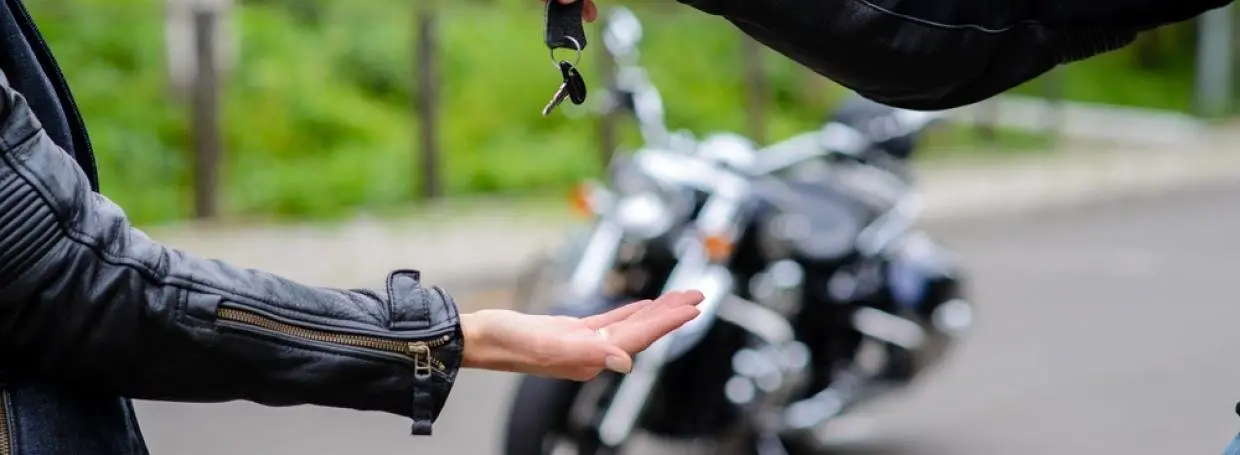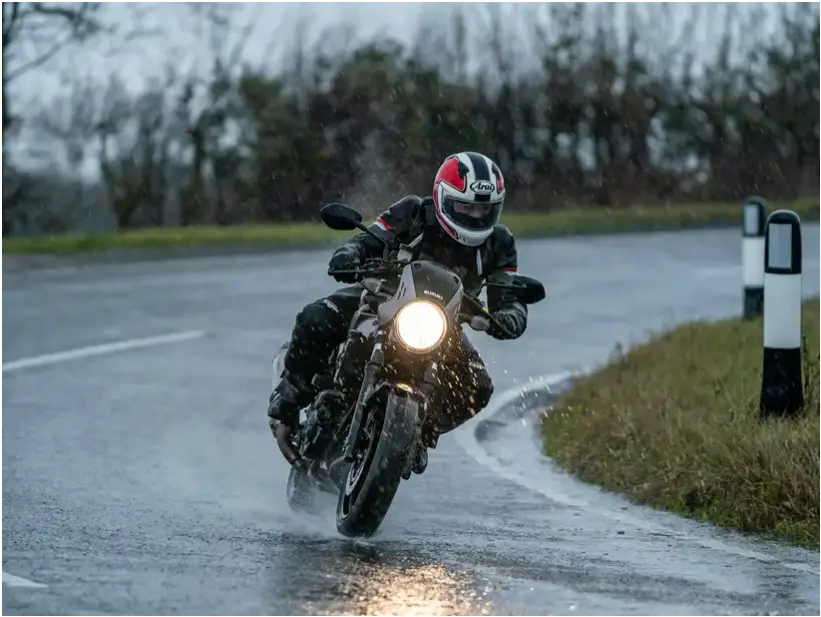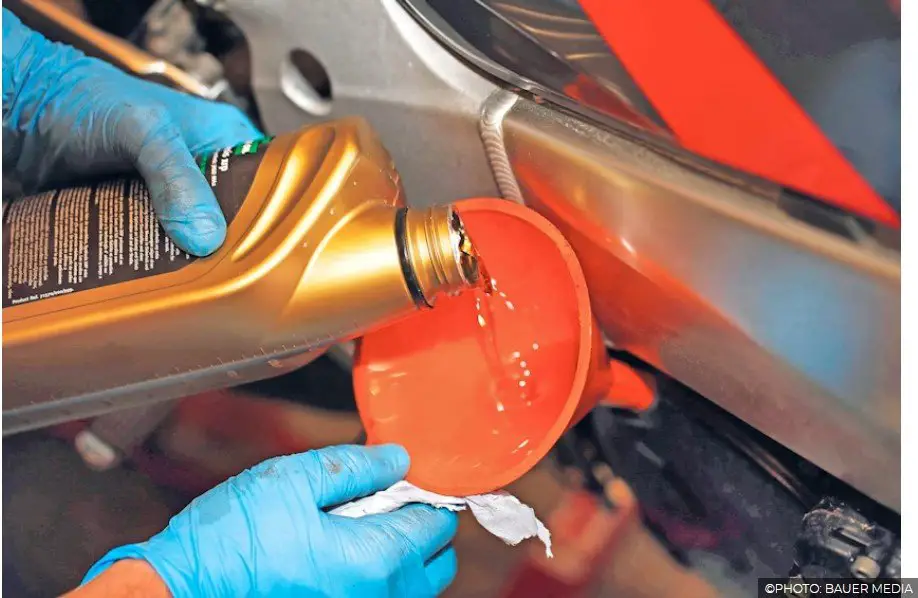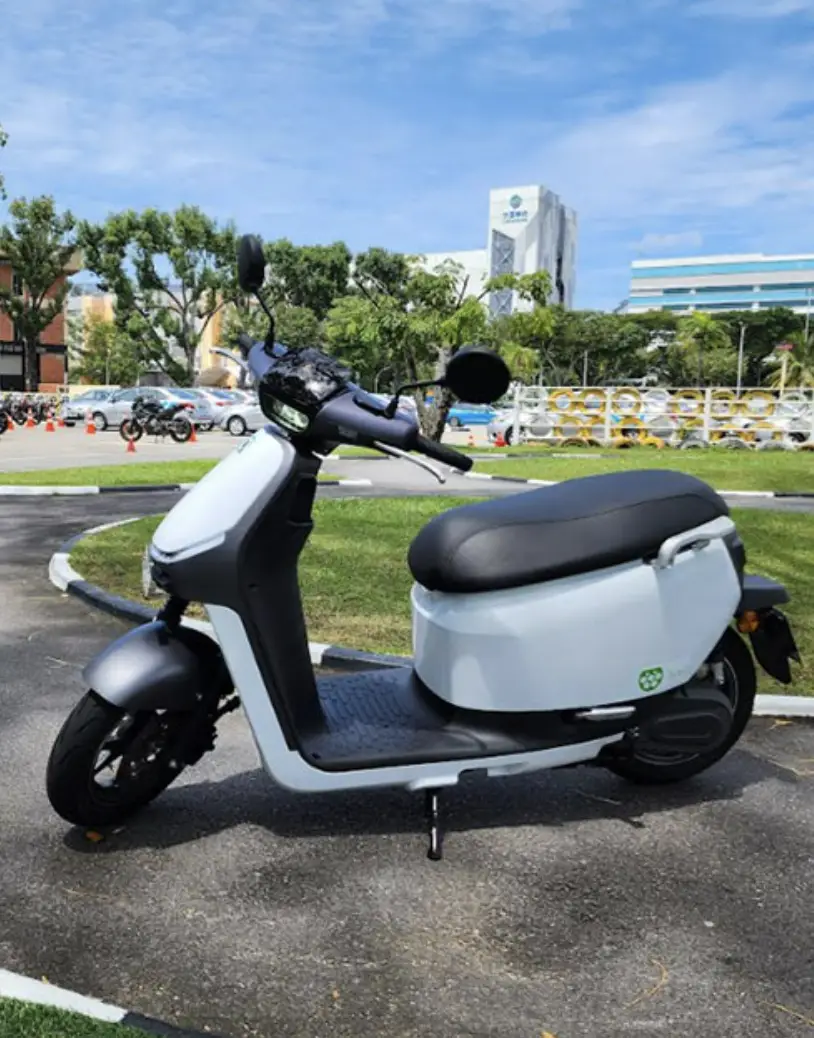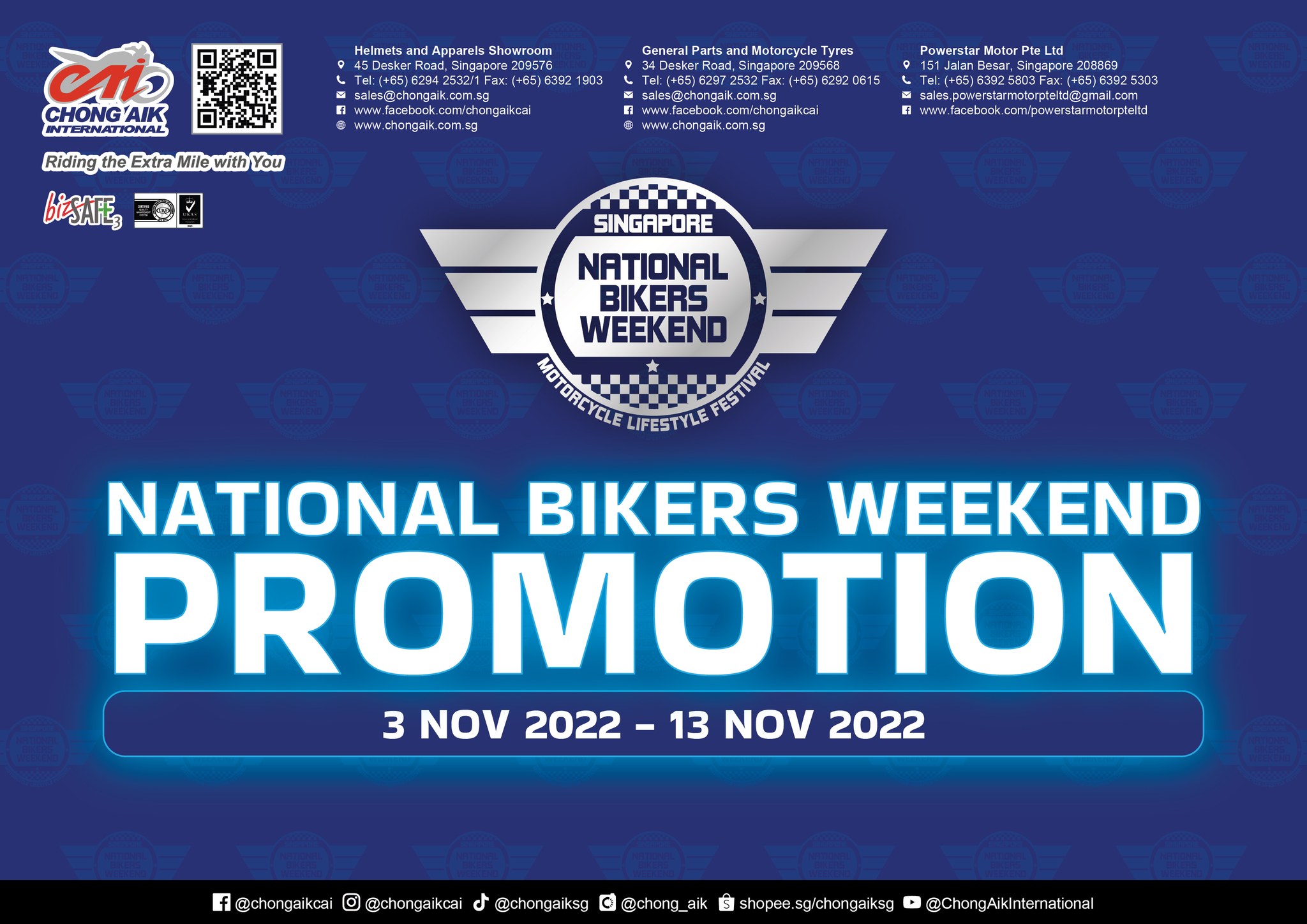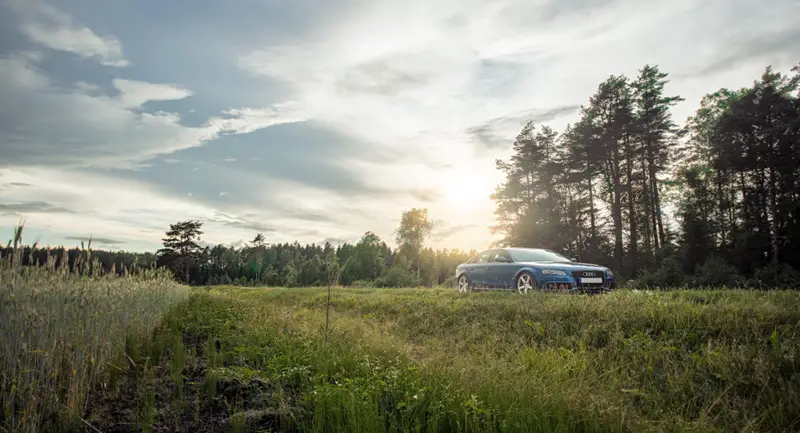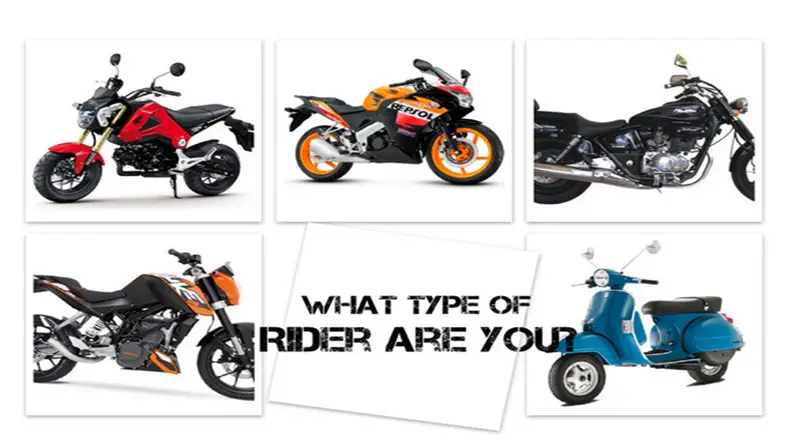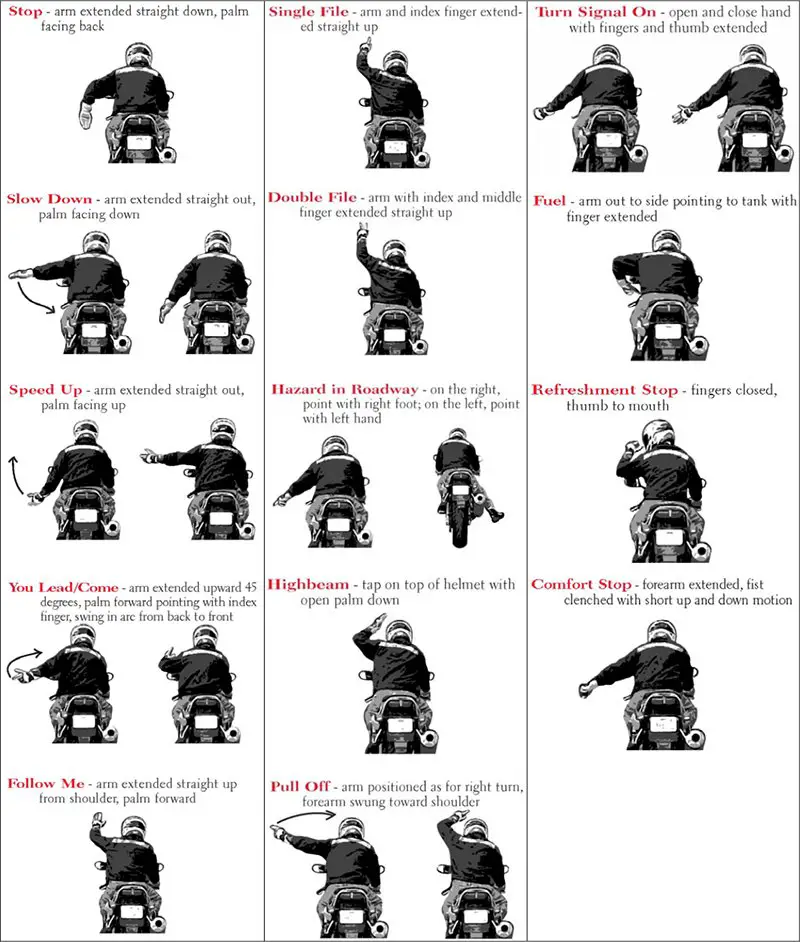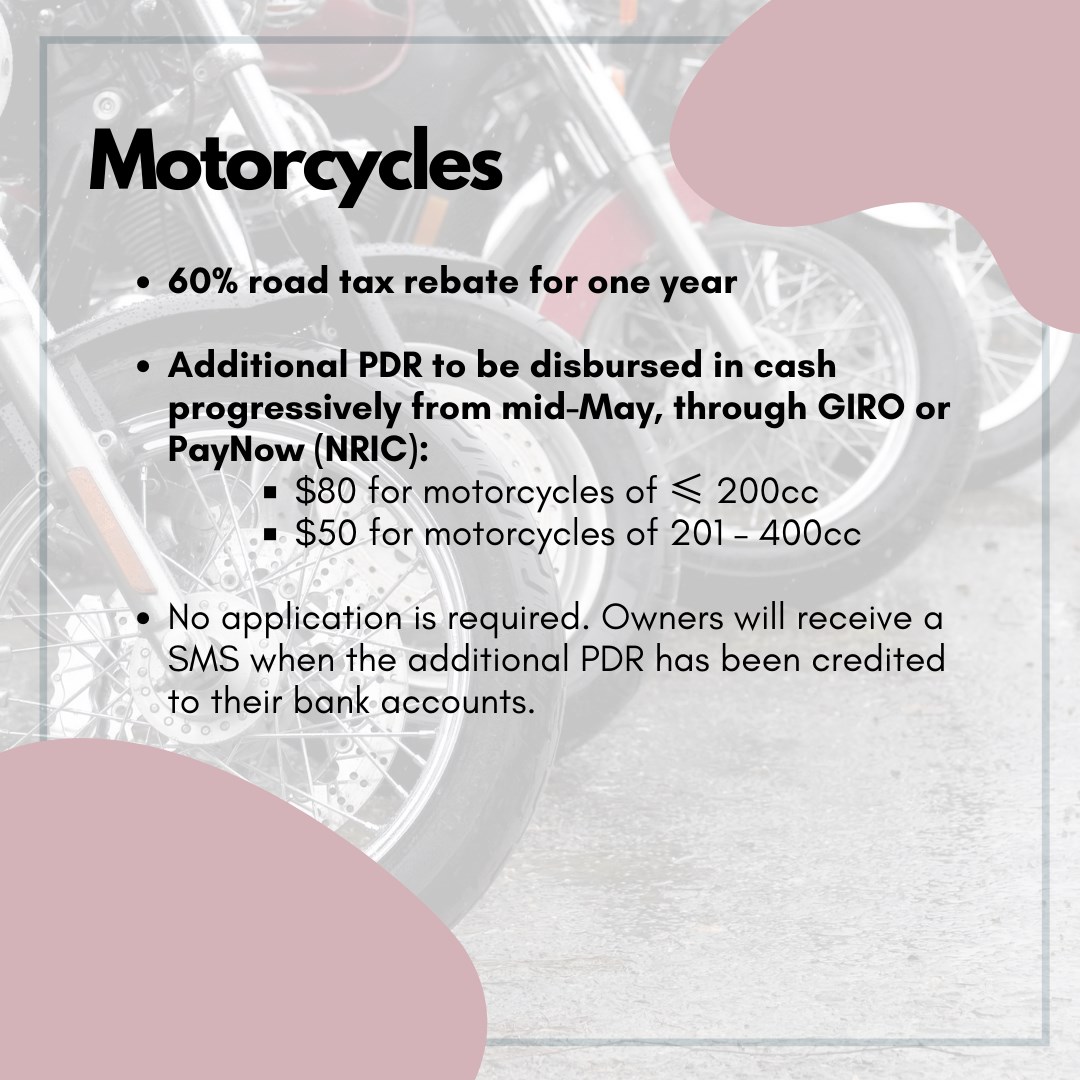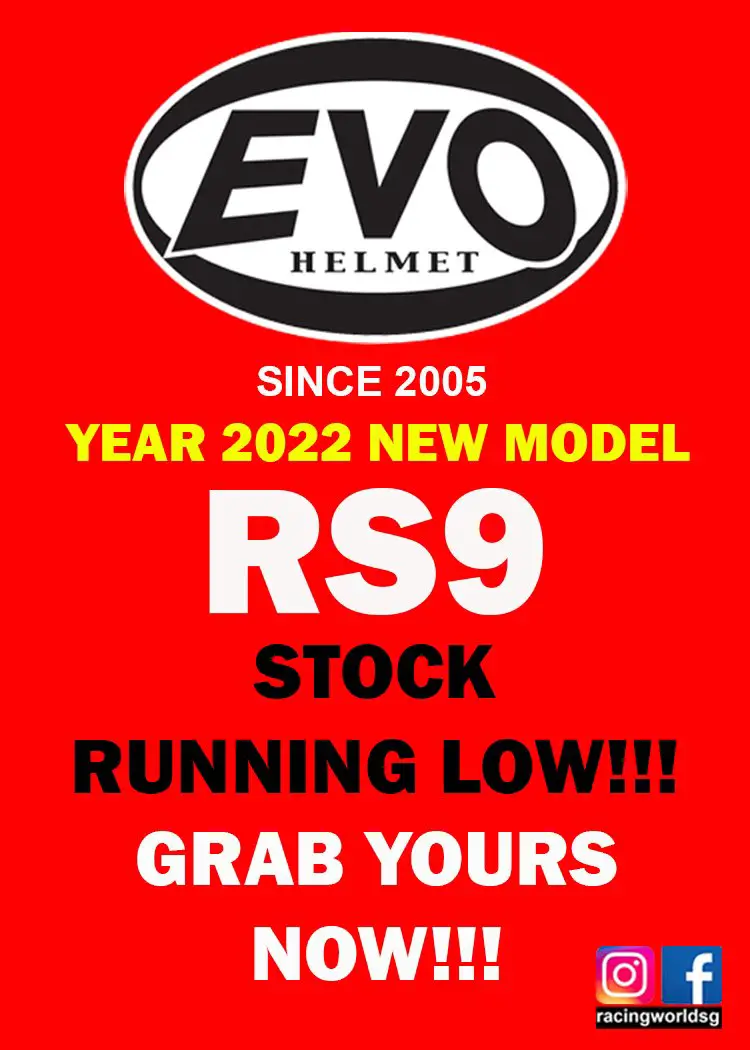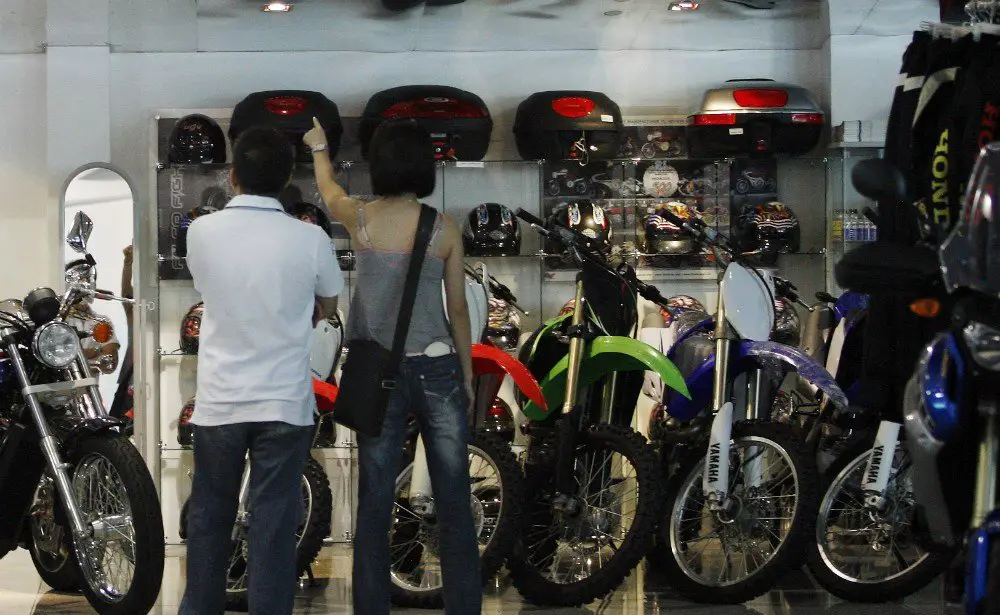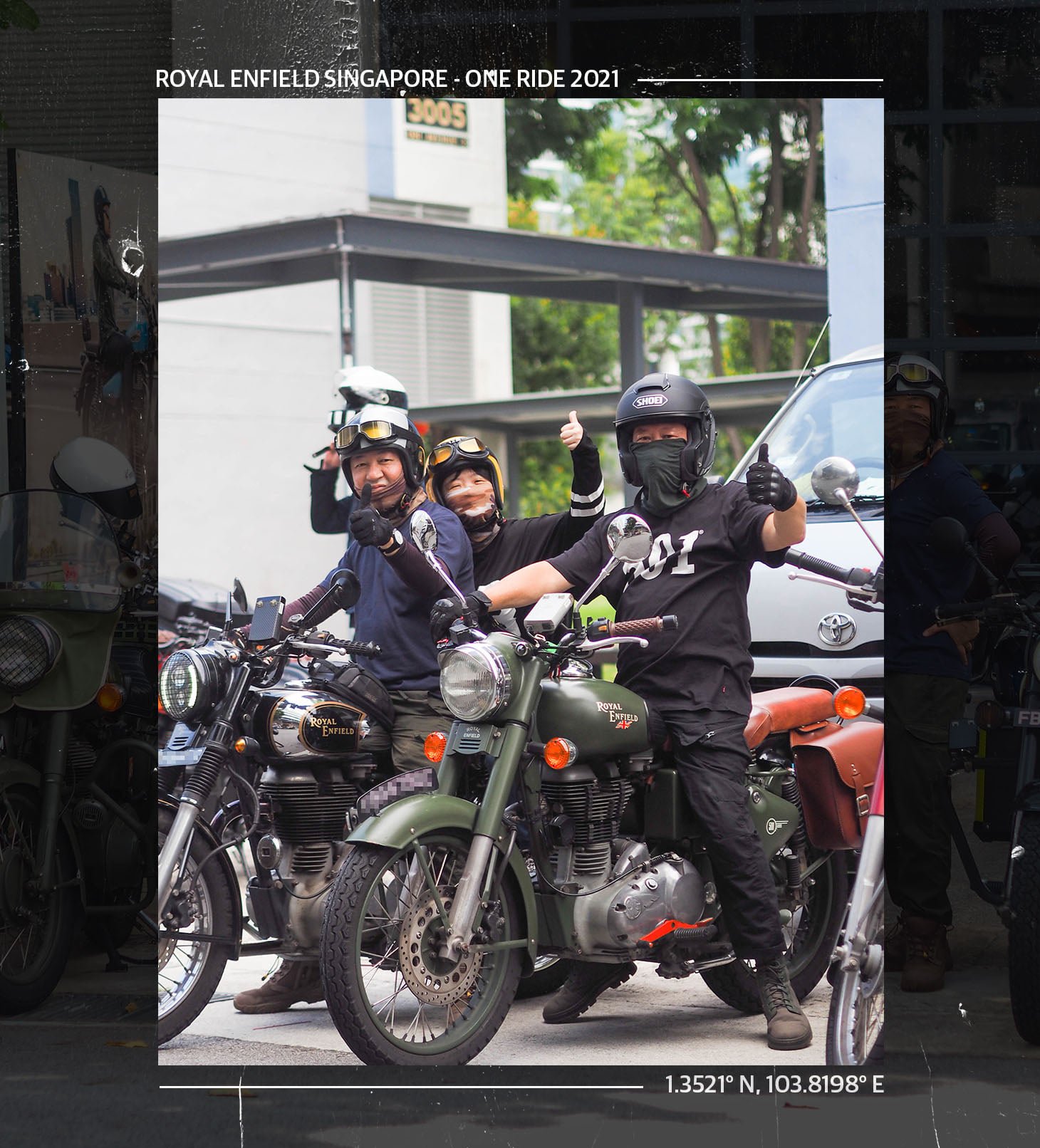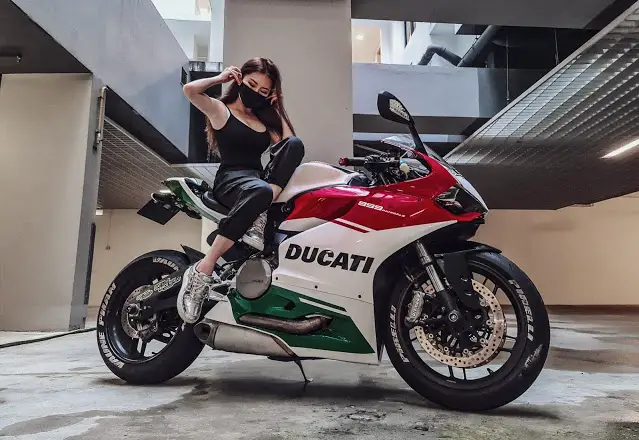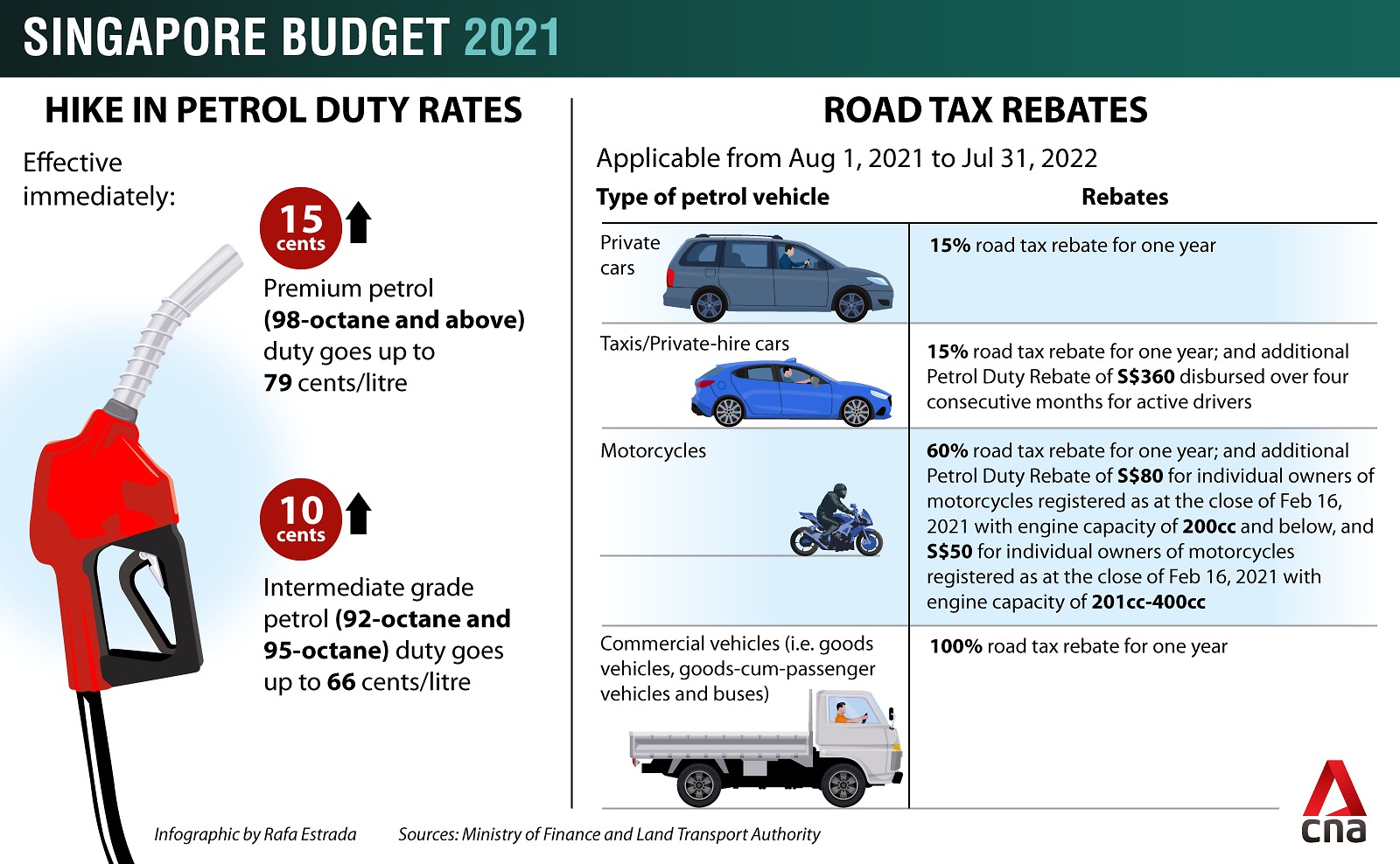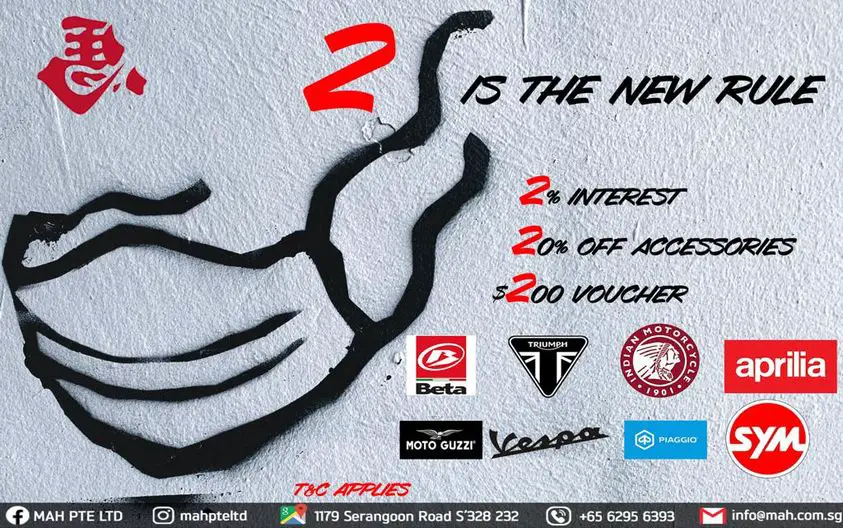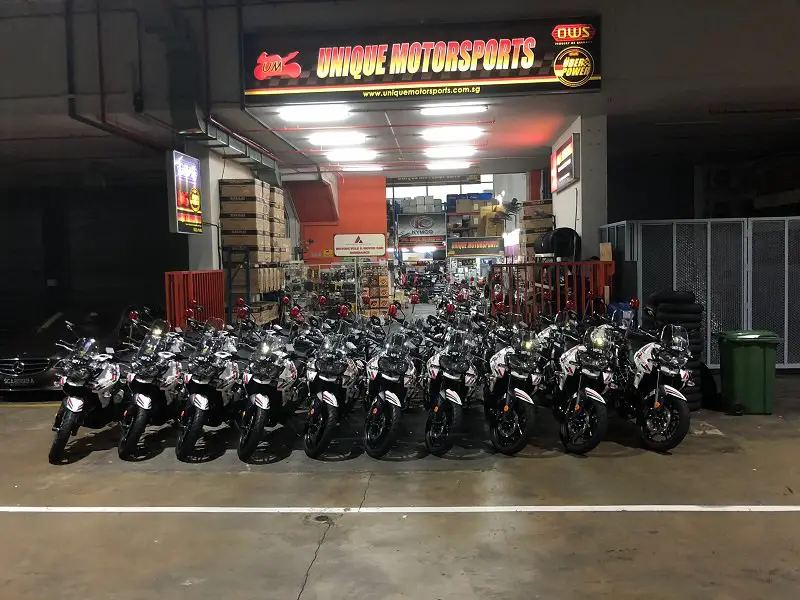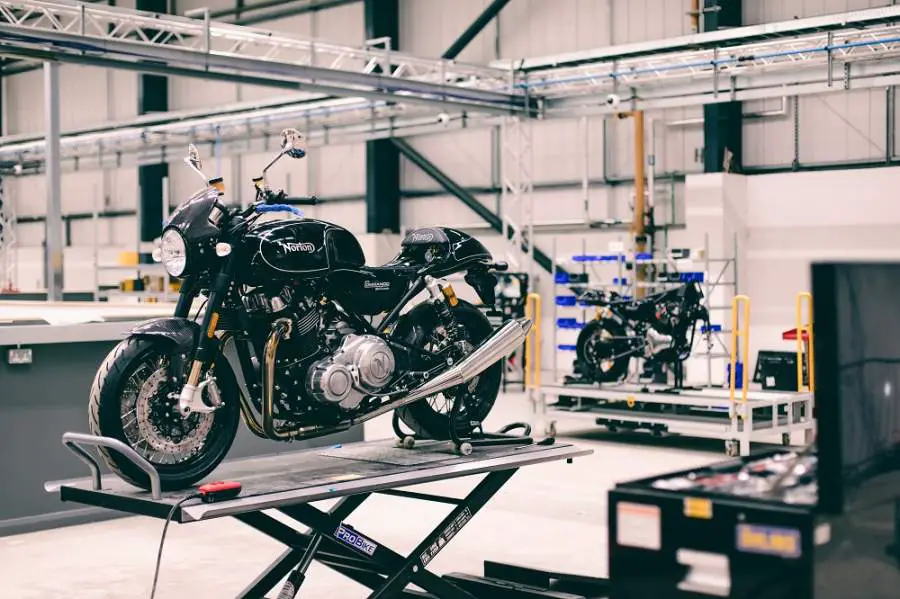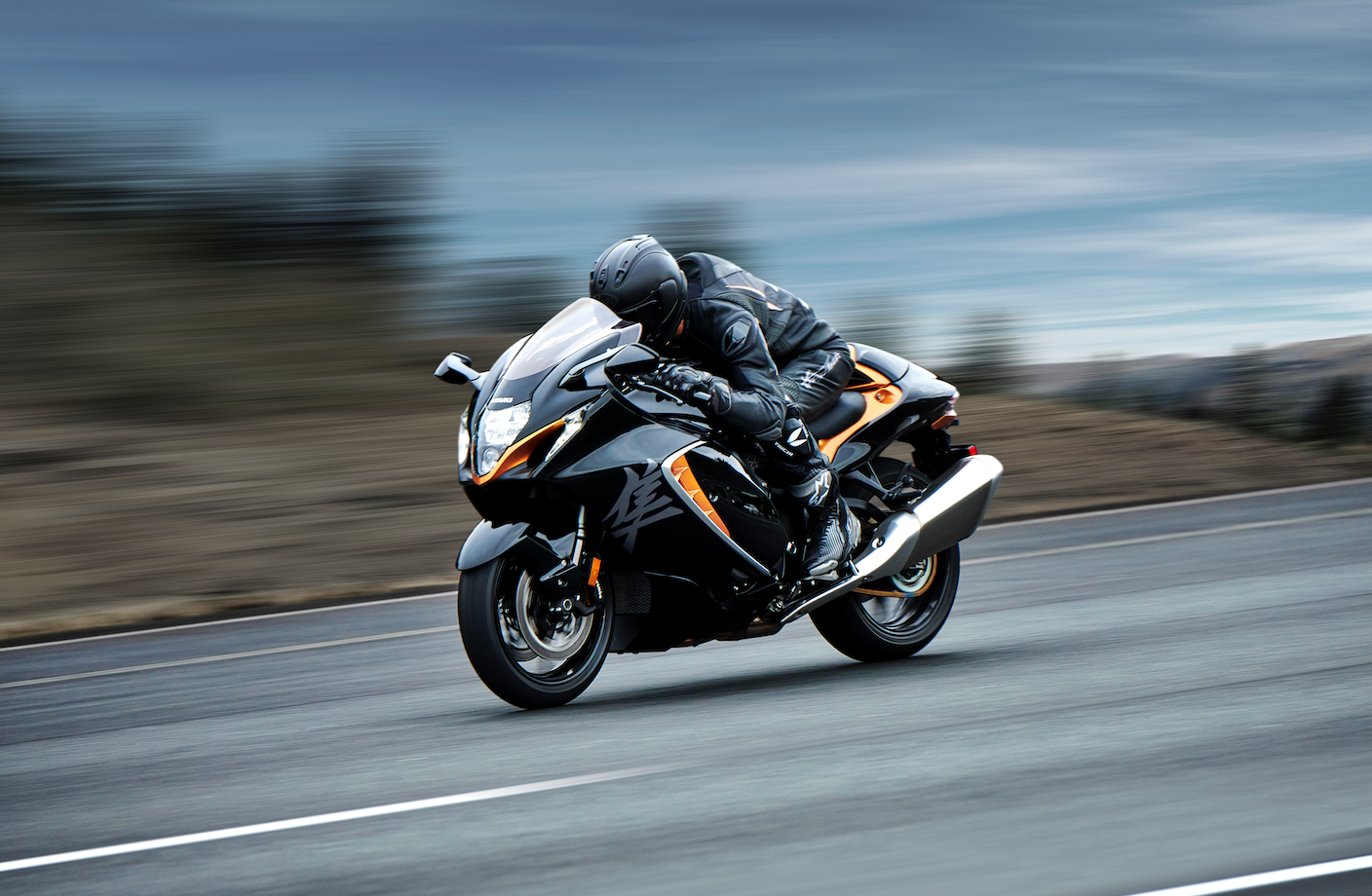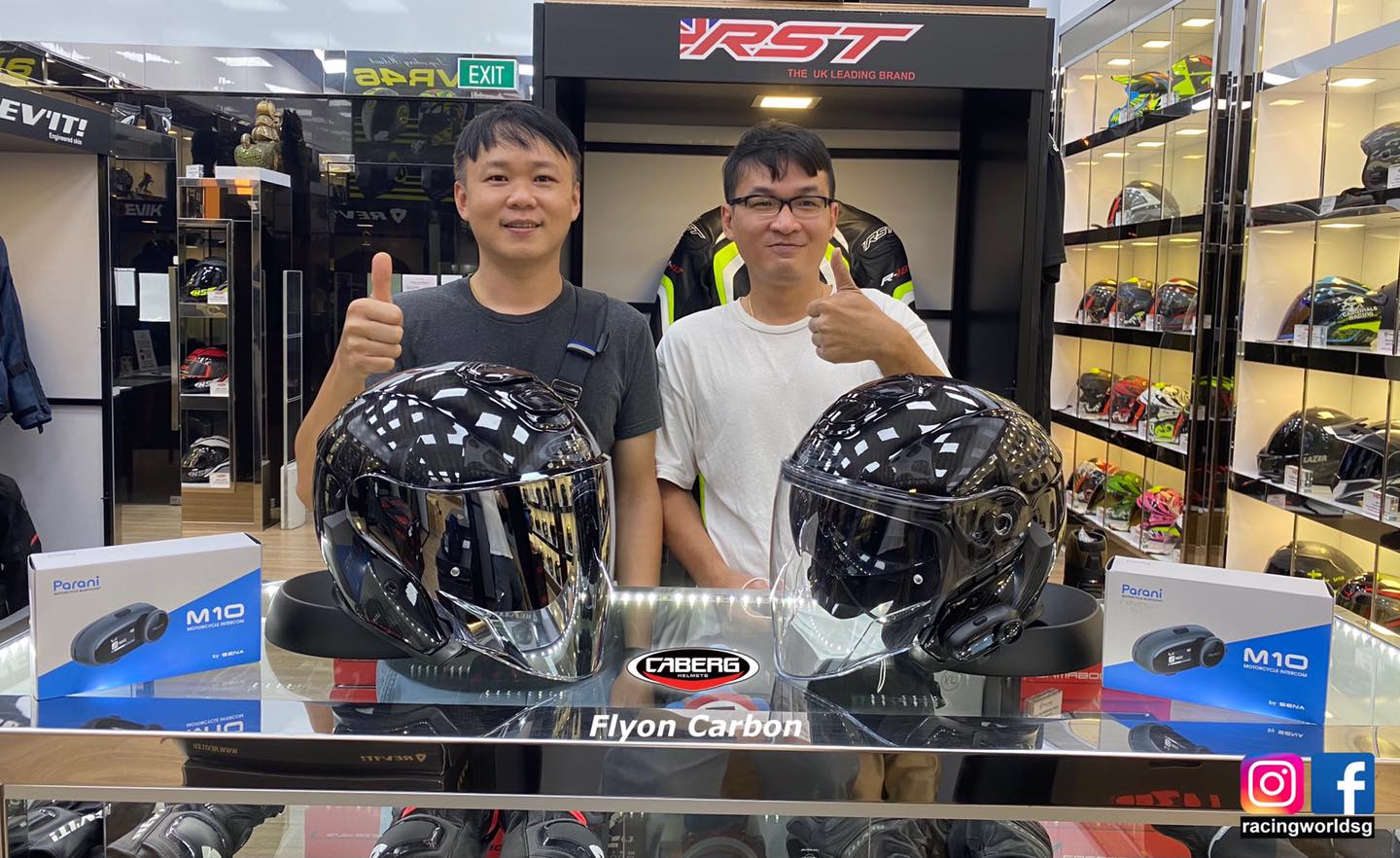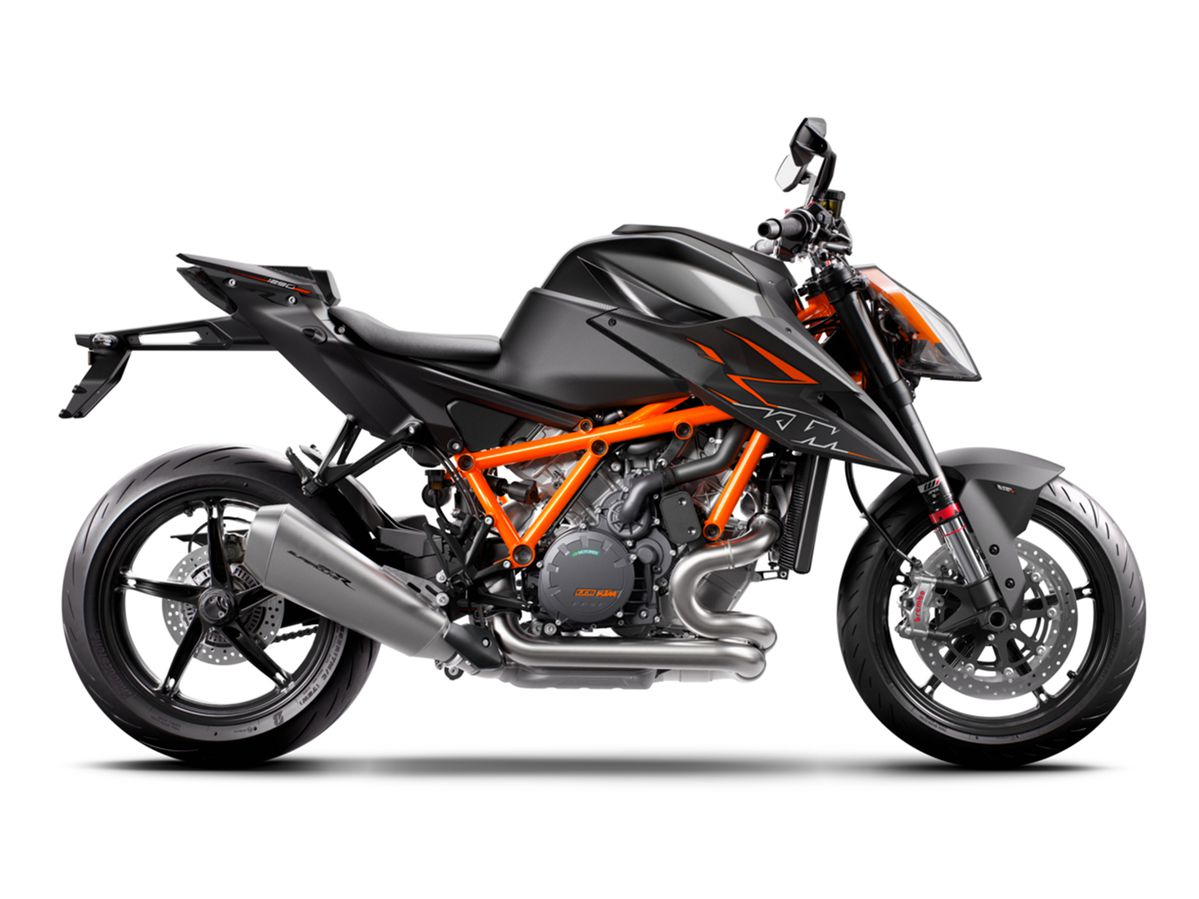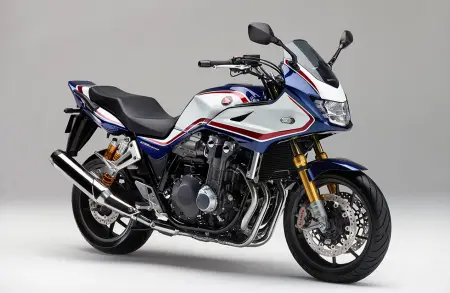Leaderboard
Popular Content
Showing content with the highest reputation since 12/01/2020 in News
-
7 Mistakes to Avoid When Buying a Second-Hand Motorcycle + Inspection Checklist! Transportation is always the talk on everybody’s tongues in Singapore. With our exorbitant car prices, you may find yourself turning instead towards the idea of riding a motorcycle around town. It’s a sleek, agile, and cost-effective solution that offers not only a more affordable means of getting around but also unparalleled freedom and flexibility. Hurrah to no longer being held prisoner by fixed public transportation timings! Now, before you start that engine and ride off into motorcycle ownership bliss, there are other things to consider, such as… buying one first. New motorcycles can cost anywhere from $5,000 to $20,000, and there’s also that (not so) little thing called COE (Certificate of Entitlement) to consider in your budgeting, which itself is a good close to $10k on its own! For a wallet-friendly alternative, you might think about buying a used motorcycle instead of a new one. Well, here’s where we come in to point out 7 mistakes you want to avoid when purchasing a second-hand bike. Read on and you’ll thank us later! Mistake #1: Not buying the right engine size to match In Singapore, a Class 2B licence allows you to ride a motorcycle of up to 200cc on public roads, whereas you’ll need a Class 2A licence for bikes of up to 400cc. If you already have a Class 2 licence, then you can choose whatever kind of motorcycle you fancy. First of all, you should be looking only at motorbikes that fit your particular licence type. Secondly, you should choose a motorcycle that matches your experience and riding level. If you’re a new rider, it’s ideal to start off with a smaller engine size so you can get used to your bike’s handling before upgrading to a more powerful motorcycle. Mistake #2: Not checking the number of years of COE left on the bike Don’t just get excited over a low price and a shiny photo. How much a motorcycle’s value is “worth” largely depends on how many years of COE are left on that motorcycle. If the COE is close to expiring and you can’t afford to renew it (does anyone really have $10k just lying around, really?), then look for another bike with more “rideable” years on it. Of course, the more years of COE left on a motorbike, the more expensive it’s going to be. Mistake #3: Trusting all listings People are going to market second-hand motorcycles in the most attractive ways, and this can affect the prices you see when combing through listings. Some ads will offer an extremely low “ride away” price, but they might belong to dealerships that have folded the actual selling price into the loan they want you to take up with them. Ads marked “COI” (Certificate of Indebtedness) point to sellers who still owe money on a loan and want to transfer the remainder of the loan over to you to pay for it. Dealership loans can come with high interest rates that may go beyond what you actually wanted to pay for a used bike, so be careful. The most important thing to do is to do your due diligence and research carefully. Remember also that prices of second-hand motorbikes in Singapore can be negotiable. Work with the sellers who are happy to offer you what you want at a price that suits your budget range. Mistake #4: Immediately turning on the engine You’re looking at this beautiful second-hand motorcycle right in front of you now. You can’t wait to throttle it and listen to that wondrous roaring sound of the bike’s engine. Well, hold your horses, because it’s best to inspect a motorcycle first when it has a cold engine. Request to the seller beforehand to let you cold-start the motorcycle when you’re there. One reason for this is to allow you to check certain areas of the motorcycle first before starting it up. This is especially important for inspecting the exhaust. (Never touch a hot exhaust!) Using your hands and some force, check that the exhaust is solidly mounted. Look all around the exhaust for any hidden areas of corrosion or unwanted dents that could potentially cause performance issues. While the engine is cold, take advantage of this time to remove the radiator cap and check if there is any oil in the cooling system. Oil floats on top of water; if you see that, it could mean engine problems. Another reason to cold-start the bike is because starting the engine is generally smoother and requires less effort when the engine is already warm. However, what you want to test is exactly how it starts up from a cold engine. While the motorcycle is warming up, take note of these things: Is it difficult to start? The battery might need replacing. Is the engine running smoothly or is it chugging? There might be potential issues with fuel, air intake, or the spark plug. Look behind, is the motorcycle smoking? A normal road bike should not be smoking. This could point to problems like burning oil or leaking coolant. Those are big problems that require major repairs. Do you hear any knocking or rattling sounds from the motorcycle engine? It should sound smooth and consistent. Any strange noises coming from the engine could mean issues such as loose components, worn bearings, or valve train problems. Which brings us to… Mistake #5: Not following this inspection checklist It’s easy to get excited about buying a bike you really like; you might give it a once-over and think, “Okay, well, it looks quite good, I’ll take it.” When it comes to investing your hard-earned money into a second-hand motorcycle, take the time to make sure you’re getting a good return on your investment. This is a great list of 15 areas to inspect when checking out a used motorbike: Area to Inspect What to Look Out For ☑ Frame Cracks, bends, dents, signs of welding ☑ Odometer Mileage is consistent with bike’s age ☑ Engine Listen for smooth operation, no leaks or smoke ☑ Oil What you don’t want to have: Metal flakes (engine is falling apart) Milky/foamy (water contamination) Burnt smell (overheating) Dirty oil (poor maintenance) Low level oil due to leaks ☑ Fuel tank, fuel lines No rust inside the tank, fuel lines not cracked or leaking ☑ Coolant If it’s brown, it could be rust or oil in the engine ☑ Exhaust No smoke, damages, holes or rust ☑ Tyres Good tread depth, no cracks or uneven wear ☑ Brakes Brake pads not worn out, brake parts not warped No noise upon braking and no drag upon release ☑ Clutch Consistent engagement point, no unusual noises ☑ Suspension Compress and release smoothly without noise ☑ Chain Chain should wrap snugly around the sprocket, not loose Tip! At the three o'clock position, gently pull the drive chain away from the rear sprocket; it should remain halfway engaged with the sprocket teeth. ☑ Sprockets All in good condition, not hooked or chipped ☑ Electrical system Check lights, indicators, horn, battery condition ☑ Controls and cables Check throttle, clutch, brake levers, no fraying cables Pro tip! One easy way to check if a used motorcycle has been in an accident is to inspect the steering stops on the front of the frame. This is what keeps the steering in place, so it can’t go too far to the left or right. If the metal there is bent or damaged, it could potentially mean that the motorcycle might have been in a crash before. You can also bring along a friend who is a more experienced motorcyclist to help you do this inspection. Mistake #6: Not being thorough in the details So, the motorcycle looks good, no damage, inspection cleared, the test ride even went well. Now, let’s talk business. This is when you should really get down into the nitty gritty about all the things you need to know before purchasing this second-hand motorcycle. Here are 4 things you should absolutely ask about: 1. Service History The seller should have a record of all prior work done to the motorcycle. If they have always done their servicing with a particular mechanic or workshop since the beginning, and they know the bike inside and out, you can even consider going back to the same workshop. Note that certain sellers who themselves are motorcycle mechanics may DIY their repairs instead of taking it to approved workshops. It doesn’t make the motorcycle any less good; but they should still be able to provide repair receipts. 2. Registration / VIN Before finalising your purchase, meticulously compare the motorcycle's VIN number and licence plate number with those listed on the title document to ensure they match. You can typically find the VIN number on the frame's steering head. Ensure all numbers are clear and haven’t been tampered with. 3. Fully Paid For Ask for proof that the seller has fully paid off the COE for the motorcycle. If they purchased the motorcycle on a Hire Purchase scheme, make sure that all instalments have been paid off. Otherwise, LTA (Land Transport Authority) will disallow the transfer of ownership. 4. Check all LTA-related details You’ll want to know where this motorcycle stands when it comes to the LTA. Ask about remaining road tax, any late payment of fines, and the last inspection date of the motorcycle. If the motorcycle you’re purchasing has any modifications done to it whatsoever, make sure that they are LTA-approved modifications. Note that some LTA-allowed modifications require pre-approval, while some are perfectly alright without any written approval from LTA. For peace of mind, ask to take the motorcycle to a LTA-Authorised Inspection Centre for an assessment. Mistake #7: Not purchasing motorcycle insurance You’re very sure that this is the motorcycle you want. Now it’s time to arrange an appointment with the seller to head down to LTA for the official transfer of ownership process. But wait! There’s one thing you’ll need to do prior to transferring ownership at LTA. You need to make sure you have at least a Third Party insurance policy for the motorcycle that you are planning to buy. Take the time to consider which type of motorcycle insurance coverage is most suited to your needs. Consider also optional add-ons, such as “New for Old” where your motorcycle will be replaced with the same/similar make and model if it is stolen. Research Thoroughly Buying a second-hand motorcycle in Singapore is not difficult, but it will take up some of your time doing your due diligence in comparing offers, and checking the road-worthiness of the motorcycle you plan to purchase. Finally, don’t forget to gear up with the right protective motorcycle gear, especially a motorcycle helmet that comes with a PSB approved sticker. Good luck, and ride safe! Article Credits: DirectAsia Join SingaporeBikes on Telegram for more of the latest news, special offers, reviews of motorcycles, and more!1 point
-
1 point
-
Like dodging downpours? Find out how to ride your motorcycle in rain The latest rubber offers incredible wet weather grip, but we often wonder whether it helps to be a bit obsessive about riding a bike. Obsessive people think about every detail, and test the smallest little things to see if they make an improvement. Nowhere is that mindset more useful than when the wind is howling and it’s pouring with rain. The critical problem with rain riding isn’t tyre grip or smooth throttle response. It’s being able to see where you’re going, and concentrate. Being dazzled by oncoming traffic in the dark, or making a poorly-timed overtake because you’re freezing your tail off – these things are far more problematic than a slippery road. Look after your visor Clear vision is even more important in heavy rain. This is doubly important as rainwater also tends to cling to a mucky visor, further reducing what you can see. Use an anti-fog device such as a Pinlock on your visor to prevent it steaming up, and try to avoid opening your visor, as once rain gets on the inside it can be very hard to clear. How far should I be from the vehicle in front? You need to double your braking distance in heavy rain for two reasons. Firstly because you physically can’t stop as quickly as in the dry and, secondly because your visibility is impaired, which will give you less time to react. Which lane is safest when it’s wet? Generally speaking, on dual carriageways and motorways the inside lane holds the most water. This is because trucks often create two ‘gutters’ – deeper channels of water where the lorry wheels run. Beware, especially when moving back into this lane. Danger lurks in dips Dips or undulations in the road will hold water. One classic location is where a road passes through a tunnel under a larger road. Take particular care in autumn as leaves can block drains causing flooding. How do I ride a motorbike in deep water? With extreme caution. Are there any obstructions you can’t see? Do you know for certain how deep it is? If you decide to enter, do so slowly and try to avoid braking. Get the right motorcycle tyres for riding in the rain Over the years tyre development means the level of grip in cold and wet conditions has improved vastly. Even so, sport or trackday tyres aren’t going to work as well as all-purpose/touring tyres in the wet. If you intend to ride throughout winter choose the correct rubber. The difference between a trackday tyre and a winter tyre in the wet is huge. Tyre pressure is vital too; the grooves in the tyre won’t work correctly in the wet if the pressure is too high or too low. Do I need electronic aids on my motorbike? From 2016 when Euro4 regulations came into effect, it became a legal requirement to have anti-lock braking systems (ABS) installed on all new bikes over 125cc capacity, and for bikes of any size you also now need either ABS or a linked braking system. If you’re lucky enough to have rider aids on your older bike, use them. Turn up the traction control, turn down the power and make sure the ABS is activated. All too often we forget about rider aids or just don’t bother. If applicable, also adjust the suspension as some bikes have a wet mode which makes the suspension softer. How do I brake in the wet on a motorcycle? Like most other things in life, braking in the wet is straightforward if you plan ahead. The first part of the plan is to practice applying the brakes on a traffic-free stretch of road with a consistent road surface. Start out slowly, focussing on the front brake and building up the lever pressure gradually so that you get more and more of a feel for the power of your brakes and the feel of the tyre on the road. When a tyre is getting close to skidding it loses speed rapidly before lock up. If you are focussed on your braking you’ll feel it in your hands and all you’ve got to do is release lever pressure and the tyre will speed up and you’ll continue to slow down in control. And the great thing about the wet is that although the ultimate limit is earlier, the zone when it starts to break away is wider so you’ve got more time to react. But that doesn’t mean you can ride up close to other vehicles because the fact is they can stop harder than you can and if you don’t leave plenty of room ahead you could be picking your bike up off the floor, so make sure you plan to have plenty of distance between you and other vehicles. Be smoother too, as sudden changes of input will unsettle your bike and make it harder for you to keep that vital feel for what’s happening under your backside. When you are braking more smoothly and gently in the wet that will bring your rear brake into play more as there’s less weight transfer, so get a feel for that too, making sure the pedal is positioned just under the sole of your boot. Still up for riding your motorbike in the rain? Check out the following waterproof kit recommendations on MCN: How to ride your motorcycle on a trackday in the rain Don’t let rain wreck your trackday! Here are some tips to help make you a wet circuit master, from MCN’s very own Chief Road Tester, racing and track driving specialist, Michael Neeves. Be an old smoothie Rain doesn’t need to spoil your trackday but the key to safe riding in the wet is being smooth on the controls and shifting your weight around. Concentrate on the straights; braking and accelerating hard when upright, and taking it steady in the corners. Be progressive on the brakes Gently release the throttle and wait for the weight to transfer to the front tyre before braking. Squeeze the front brake lever lightly at first, to get the front tyre dug in, then progressively harder, feeling for grip. Finish braking before tipping-in. Blip the throttle on down-changes to reduce engine braking. V-shape cornering Do your turning off the brakes and with a neutral throttle to give the front tyre the best chance of gripping. To stabilise the bike, and give you one less to think about on the way in, hang-off way before the braking zone so you’re in the correct position before the turn. Keep the bike as upright as possible into, through and out of the corner, taking pointy V-shaped lines. Wide, swooping arcs means leaning on the front tyre’s tiny contact patch which is risky. Note the slippy zones Remember where the slippery bits of track are and mentally log them for the next lap. You might have to ride off-line to avoid the smoothed-out tarmac of an apex, and you should always accelerate gently out of an off-cambered corner. Avoid painted kerbs like the plague and watch out for painted grid spots. Give it a spin Build confidence by deliberately making the rear wheel spin in a straight line on a long, un-cambered piece of track. You’ll be surprised by how much it actually takes to get the rear to break traction. Stay on the fat rubber Hang-off to reduce your lean angle and gently pick up the throttle to get the weight transferred to the rear tyre. Only accelerate hard when the bike is completely upright. What tyres? Sports touring rubber is the most suitable in the wet – sticky trackday tyres simply won’t work. Keep the heat on You could use tyre warmers on wets (on a low heat setting) to make them pliable, but as soon as you take them off they’ll quickly lose heat as you go from the paddock to the track. It’s better to start cold and gradually build speed, adding heat, grip, and confidence as you go. Article Credits: MCN Join SingaporeBikes on Telegram for more of the latest news, special offers, reviews of motorcycles, and more!1 point
-
How to: Change your motorcycle engine oil The oil in your engine is its lifeblood: it lubricates the moving parts and stops them wearing or destroying themselves; it helps keep everything cool, particularly on ‘air’-cooled engines; and it removes harmful deposits and helps prevent them from building up again. Oil eventually deteriorates as a result of heat cycles as well as its intended purpose of carrying dirt and debris away from key parts of the engine, and so it needs changing regularly to make sure it can keep doing its job. But changing it is a very straightforward process and is well within the scope of the average home mechanic. There are different types of oil; mineral, semi-synthetic and fully synthetic. The former is derived entirely from crude oil and is well suited to lower-specification engines that don’t run at high revs. Semi-synthetic uses a mixture of mineral and synthetic oils to add a range of qualities that help offer higher performance for more complicated engines. Fully synthetic is, as the name suggests, man-made and can be tailored to give whatever qualities are required but is the most expensive option of the three. There are then several identifiers for the compatibility of oil for your bike. The first is the American Petroleum Institute which rates oil for performance, the ‘higher’ the letter, the better. So, for example, an oil rated API SN means it is certified for a spark-ignited engine (the S) and performance level N, which is higher than M or L. The second rating is the Japanese Automobile Standards Organisation (JASO) rating that indicates whether an oil is suitable for a bike with a wet clutch – which runs in the same engine oil – or not. An MA rating means oil that will maintain the engine and transmission and allow the wet clutch to operate effectively. Oils also have a viscosity rating expressed by numbers and letters as part of the SAE (Society of Automotive Engineers) rating. For example, SAE 10W30 means the oil works in ambient temperatures down to -25°C (the number before the W for ‘Winter’ is the coldest working temperature) up to 30°C. Note these are ambient, not the engine, temperatures and the higher the numbers, the higher the temperatures. You may also see 4T and 2T on the bottle – this means they are designed for four-stroke and two-stroke engines respectively. Here’s how to change your oil and keep your engine happy. Step 1: ©PHOTO: BAUER MEDIA Look in your owner’s handbook or workshop manual; these should tell you the specification of oil you need and the quantity. Get yourself online and order the necessary quantity as well as the relevant replacement oil filter and a new washer for the drain plug. Step 2: ©PHOTO: BAUER MEDIA Run the engine for a short while to warm the oil up but not get it too hot. Warming it up will help it drain so as much of the old oil comes out as possible. Place a drain tray underneath the drain plug and, having put a pair of protective gloves on (old oil is fairly unpleasant stuff), loosen the drain plug and remove it by hand. TIP: While you are undoing it, push it in to get the threads to seal as much as possible and don’t try to remove it until you feel the last thread come loose – this will help prevent warm oil running down your arm. Leave the oil draining for now. Step 3: ©PHOTO: BAUER MEDIA Now you need to think about how you are going to remove the old oil filter. There are two main ways to do this – with a cup-style filter wrench that fits the flats on the filter and drives from a socket handle or a strap (or chain) wrench that tightens onto the filter body as you rotate it to loosen the filter. The choice comes down to personal preference or what’s available for your bike. Step 4: ©PHOTO: BAUER MEDIA The wrench fits over the end of the filter housing and is very easy to use – you locate it like a large socket and use a ratchet or handle to undo it until it is hand tight and you can remove it. Be careful of the oil spill as you do so and lay plenty of rags or paper towels under where it locates, particularly if it is angled downwards as you work on it. Step 5: ©PHOTO: BAUER MEDIA A strap wrench tightens itself on as you rotate it until it grips the filter housing and begins to rotate it until you can again, remove it by hand. These can be useful if access is tight or you can’t get a wrench over the top of the filter and get a handle to it directly. Step 6: ©PHOTO: BAUER MEDIA Once the filter is off the engine, remove it and when convenient, drain its contents into the drain pan that now contains the contents of the engine. Use some carburettor cleaner or degreaser to clean the mounting face ready for the new filter. Step 7: ©PHOTO: BAUER MEDIA Before fitting the new filter, smear a thin layer of oil around the rubber ‘O’ ring - this will help it seal properly. If the filter is mounted directly from the bottom of the engine, you can fill it with new oil to ‘prime’ it. If it isn’t then fit it empty and it will fill when you first run the engine. Step 8: ©PHOTO: BAUER MEDIA Fit the new filter to the threaded section where the old one was removed from. Tighten it as per the instructions in the owner’s or workshop manual – this may be a torque value or a specific process. Step 9: ©PHOTO: BAUER MEDIA Before you refit the drain plug so you can refill the engine, have a look at it to see whether there is evidence of worrying wear – metal particles, for example. If not, give it a clean and remove the old washer, replacing it with a new one. Step 10: ©PHOTO: BAUER MEDIA Now refit the drain plug and tighten it to the relevant torque figure, as per the owner’s or workshop manual. Step 11: ©PHOTO: BAUER MEDIA It’s now time to refill the engine with lovely clean oil. Using a funnel – to actually get it into the engine – or a measuring jug, either apply a measured quantity, taking into account any you may have already added to the filter before fitting it or fill to a level in the sight glass or on the dipstick, depending on your bike. Make sure the bike is upright and level when checking oil levels. Step 12: ©PHOTO: BAUER MEDIA If filling to a level, check this with the sight-glass or dipstick and fill until you are roughly halfway between the upper and lower marks. Stop, then run the engine for a moment to circulate the oil, then shut off and wait until the level has settled and check again, as per the manual. If necessary, add more to compensate for filling the filter and there you go – job done. Aricle Credits: motorcyclenews Join SingaporeBikes on Telegram for more of the latest news, special offers, reviews of motorcycles, and more!1 point
-
Mah Pte Ltd: Preorder new Kawasaki ZX-4RR for September delivery 𝙀𝙭𝙘𝙡𝙪𝙨𝙞𝙫𝙚 𝘿𝙞𝙨𝙩𝙧𝙞𝙗𝙪𝙩𝙤𝙧: 𝗠𝗮𝗵 𝗣𝘁𝗲 𝗟𝘁𝗱 𝘾𝙤𝙣𝙩𝙖𝙘𝙩 𝙤𝙪𝙧 𝙎𝙖𝙡𝙚 𝙏𝙚𝙖𝙢: Amin: +65 9114 9428 https://wa.me/6591149428 Firdaus: +65 8292 4460 https://wa.me/6582924460 Amirul: +65 8815 2709 https://wa.me/6588152709 𝙎𝙝𝙤𝙬𝙧𝙤𝙤𝙢 𝘼𝙙𝙙𝙧𝙚𝙨𝙨: Mah Pte Ltd 1179 Serangoon Rd, Singapore 328232 Join SingaporeBikes on Telegram for more of the latest news, special offers, reviews of motorcycles, and more!1 point
-
Singapore's 1st electric motorcycle familiarisation course ComfortDelGro Driving Centre is holding Singapore’s first electric motorcycle familiarisation course starting Feb. 8, 2023. The course fee is S$50. The three-hour session is targeted at motorcyclists who are considering buying an electric motorbike and have a valid Class 2A or 2B licence and are raring to try out e-motorcycles. The course will cover both theory and practical training. Motorcyclists will be introduced to how e-motorcycles operate, how they compare to internal combustion engine motorcycles, the benefits and risks, as well as battery management and charging guidelines. Takes 90 minutes to charge up to 80% The course ends at the circuit where motorcyclists get a first-hand e-motorcycle experience on two models: The G2 Quantum (Class 2B) and the Alrendo TS Bravo (Class 2A). The G2 Quantum, which has a riding range of about 90km, has been provided by Quantum Mobility, a local start-up that is looking to start e-motorbike sales soon. The Alrendo TS Bravo, which has already been retailing here, has a riding range of 278km. Both e-motorbikes take about 90 minutes to charge from 10 per cent to 80 per cent. Electrification of vehicles & centre Vincent Tan, CEO of ComfortDelGro Driving Centre: “ComfortDelGro Driving Centre has had, in June 2022, introduced the electric vehicle (EV) option for Class 3A licence learners." "Although the e-motorcycle licensing course is not available as of now, we have decided to start off with the Electric Motorcycle Familiarisation Course first so as to pave the way for more of such similar offerings in the future.” Course Objectives: This course aims to equip riders with knowledge in the definition and operational characteristics of an electric motorcycle. It also provides familiarisation on control and devices, conducting pre-ride checks and riding an electric motorcycle safely. Course Content: Legislation Guidelines on Use of Electric Motorcycles in Singapore What is an Electric Motorcycle? How does an Electric Motorcycle operate? Electric Motorcycle versus Internal Combustion Engine (I.C.E) Motorcycle What are the benefits in switching to an Electric Motorcycle? Charging an Electric Motorcycle Battery Management Familarisation on Control and Devices/ Pre-Ride Checks Correct Riding Posture Motorcycle Handling and Balancing Familarisation Riding in CDC Circuit Article Credits: mothership Join SingaporeBikes on Telegram for more of the latest news, special offers, reviews of motorcycles, and more!1 point
-
More than $500,000 lost to vehicle-related scams since December 2022 Fraudsters would send text messages purportedly from LTA to victims to notify them of unpaid bills or fines.PHOTO: ST FILE At least 317 victims have lost about $557,000 since December 2022 to phishing scams involving unpaid vehicle-related bills or fines, the police said on Tuesday. Fraudsters would send text messages purportedly from the Land Transport Authority (LTA) to victims to notify them of unpaid bills or fines, the police said. The victims would then click on the URL link embedded in the messages to view information about the alleged bills or fines. They would be directed to fraudulent websites, where they would be required to provide their credit/debit card details and One Time Passwords (OTPs). The police said: “Victims realised that they had been scammed only after discovering unauthorised transactions made to their credit or debit cards.” The police added that LTA does not notify road users of unpaid bills or fines via text messages or request for payments for offence notices, vehicle registration, and licensing matters via URL links embedded in text messages. The payments must then be done separately on LTA’s e-payment services, Internet banking or at AXS or SAM stations. Members of the public received fraudulent text messages about an unpaid bill or unauthorised transaction made to their credit/debit card. PHOTOS: SINGAPORE POLICE FORCE The police reminded the public to not click on URL links provided in these unsolicited text messages and to always verify the authenticity of the information with the official sources or website. The public should also never disclose their personal or Internet banking details and OTP to anyone, the police said. The police advised the public to report any fraudulent bank transactions and cancel their card immediately. Those who have information relating to such scams can call 1800-255-000 or go to www.police.gov.sg/iwitness to submit a report. For scam-related advice, the public can call 1800-722-6688 or visit www.scamalert.sg Article credits: tnp.straitstimes.com Join SingaporeBikes on Telegram for more of the latest news, special offers, reviews of motorcycles, and more!1 point
-
Chong Aik: NATIONAL BIKERS WEEKEND 2022 PROMO - OUTLETS EXCLUSIVE Save on motorcycle helmets, apparel, accessories, parts, and many more with our NATIONAL BIKERS WEEKEND PROMOTION! Valid on 3 NOV 2022 - 13 NOV 2022 EXCLUSIVE AT OUR OUTLETS Check out our current ongoing promo deals at: https://www.chongaik.com.sg/content/9-promotions Visit them at: Helmets & Apparels Showroom 45 Desker Road, Singapore 209576 (+65) 6294 2532/1 9am-6pm | Mon-Fri 9am-5pm | Sat Powerstar Motor P/L 151 Jalan Besar, Singapore 208869 (+65) 6392 5803 10:50am-7:30pm | *Tue-Sun * temporary operating hours Motorcycle Tyres and General Parts 34 Desker Road, Singapore 209566 (+65) 6297 2532 9am-6pm | Mon-Fri 9am-5pm | Sat Join SingaporeBikes on Telegram for more of the latest news, special offers, reviews of motorcycles, and more!1 point
-
Direct Asia: How to Get an International Driving License in Singapore Now that traveling restrictions have been lifted, what’s stopping you from hiring a rental car and road-tripping across the country of your choice? Having an International Driving Permit can minimize inconvenience for drivers – especially in non-English speaking countries – and give you the freedom to explore the cities at your own pace. Besides, losing your way as you cruise along and discovering new hotspots with your family or friends are all part of the process. But, did you know that you may require an International Driving Permit (IDP) when you’re driving in certain countries? If you’re unsure of how to apply for one or whether you even require one, read on to find out! What is an International Driving Permit? The IDP is basically a translation of your national driving license. It allows motorists to drive their vehicles in foreign countries and it’s a United Nations regulated travel document for your benefit and safety. Just remember that you must always have your IDP together with your national license when driving, at all times. To get an International Driving Permit in Singapore, you’ll have to visit the Automobile Association of Singapore (AA). It’s the only authorized organization to issue IDPs in Singapore. Based on the Convention Road Traffic code of 19 September 1949, the IDP issued by AA Singapore has a 1-year validity from the date of issue. If you’re new to Singapore, you can drive in the country as long as you possess a foreign driving license and an International Driving Permit (IDP) issued by an authorized body from your country of origin. The IDP will not be issued in Singapore to holders of overseas driving licenses. How to apply for an International Driving Permit in Singapore? In order to obtain an IDP, you must apply for it in Singapore before you travel. There are 2 ways you can request for your IDP – you can do it online or just by walking into one of the AA Centers in Singapore. Applying for the IDP Online: You can choose to apply for the International Driving Permit online through the Automobile Association of Singapore website. The process will only take you 10 minutes and the AA requires the following: Passport-size photo NRIC (front/back) Singapore driving license (front/back) Credit/debit card for online payment of application fee ($20) However, do note that delivery will take up to 10 working days and an additional $5.50 will be added to your cart prior to checkout for this courier service. IDP Walk-In Application Process: You can also choose to head to the Automobile Association of Singapore counters where the entire process will take about 1 hour, if it’s not during peak hours. All you’ll need at the AA are these following documents: A copy of your physical Singapore driving license (front and back) A copy of your physical NRIC (front and back) for Singaporeans / Permanent Residents A copy of your employment pass/FIN Card (front and back) for foreigners A clear coloured passport-sized photograph in plain, light background of the applicant. Online applicants can submit a passport-size photo in JPG format; walk-in applicants will have their photos taken on-site at no additional charges. If you are applying on behalf of an applicant, a hardcopy photograph of the applicant is required. Take note that photographs with watermarks will be rejected so you cannot submit the photo image on your passport, NRIC or Driving License card as there is a watermark on it. Ensure you follow these requirements so your application does not get delayed or rejected. These are the 3 AA Centers in Singapore: AA CENTRE AA @ GB POINT AA @ BROADWAY PLAZA 2 Kung Chong Road #04-01, AA Centre Singapore 159140 (Walk 7 mins from Redhill MRT, exit A) Opening Hours Mon to Fri : 9:00am to 6.45pm Closed : Sat, Sun & PH 535 Kallang Bahru #01-08, GB Point Singapore 339351 (Opp Geylang Bahru MRT station, exit A) Opening Hours Mon to Sun : 11:00am to 7.30pm 4190 Ang Mo Kio Ave 6 #03-03 Broadway Plaza Singapore 569841 (6 mins walk from Ang Mo Kio MRT, exit B) Opening Hours Mon to Sun : 11:00am to 7.30pm Where Can You Use Your International Driving Permit? The IDP is valid in all overseas territories listed in the Contracting States of Convention on Road Traffic of 19 September 1949. However, it is invalid in China, Cambodia, Myanmar and Vietnam. In Sri Lanka, an IDP applicant must visit the AA Ceylon or Department of Motor Transport, with a valid Singapore driving license and IDP, to obtain a temporary driving license if you choose to drive around there. Your International Driving Permit will come in handy in these situations: Car rental Traffic violations Traffic accidents Motor insurance claims Verifying driver with photo identification To play it safe, contact the respective Embassy or Consulate Office of the country you’re visiting to obtain more information on driving license requirements, if you intend to travel for a period longer than 3 months. Get Equipped for International Travel An IDP gives you a peace of mind while you are out exploring the world even if you are not planning to drive overseas! The IDP is not only a requirement for renting a motor vehicle in many countries, it can be helpful if you find yourself in need of identification or assistance. A valid IDP also allows you to drive in most foreign countries in case of an emergency under normal IDP conditions. So, besides car and travel insurance, we suggest you get your IDP before traveling too! You can get Quote for Motorcycle and Travel Insurance from Direct Asia....... Article Credits : Direct Asia Join SingaporeBikes on Telegram for more of the latest news, special offers, reviews of motorcycles, and more!1 point
-
Cheaper Motorcycle Parking Rates in Singapore How to Get Better Motorbike Parking Rates in Singapore (2022) Parking fees are an extra daily expense that motorists can’t avoid. Unless you decide to use public transport to work of course. And while car drivers may consider $10 for all-day parking reasonably cheap, surely motorcyclists shouldn’t have to pay that much. So, we’ve put together a list of parking spots to consider, if you own a motorcycle and want to get better parking rates in Singapore. HDB Season Parking for Motorcycles If there is a HDB parking lot nearby, that’s always a good choice to park your motorcycle at a cheaper rate. Season parking at HDB areas in Singapore costs between $15 per month for unsheltered carparks or $17 per month for sheltered spots. You could even top up to concessionary season parking (CPST) for $20 per month, allowing you to park at white motorcycle lots at all HDB carparks as well as most Urban Redevelopment Authority (URA) carparks. You can apply for HDB season parking to get better motorbike parking rates via HDB’s e-Service or via the mobile app Mobile@HDB. Coupon Parking for Motorcycles Another good option for parking your motorcycle is the 65-cent HDB or URA parking, payable by coupon. You can buy the parking coupons at authorised sale outlets. This includes Cheers, 7-Eleven, most petrol kiosks and other appointed sale outlets that display the “authorised coupon” signboard at their premises. With a coupon, you can leave your motorcycle parked at a URA/HDB parking lot from 7 am to 10.30pm or overnight from 10.30pm to 7am the following day. This is definitely the most cost-effective option for motorcycle riders that wish to park at open-air carparks in Singapore, such as the downtown area. Free Motorcycle Parking in Singapore Do you know there are a few parking areas around the island where you can park your motorcycle for free? These carparks do not have any parking fee imposed from Monday to Sunday including public holidays. Here is where you can find free motorcycle parking spots in Singapore: E Hub Downtown East Esplanade IKEA Alexandra IKEA Tampines Jelita Cold Storage Junction Nine Kallang Wave Mall Kinex Labrador Park Liang Court Marina Square Millenia Walk Singapore Expo Suntec City The Chevrons Jurong Central Park (McDonalds) Ultimate Bonus: Free Parking for Motorcycles at Orchard Many people in Singapore will notice that there aren’t any parking lots for motorbikes at Orchard Road? However, if you’re willing to walk 10 to 15 minutes to your destination, you can easily find free parking for motorcycles here. These are a couple options of where to go: If you’re headed to Orchard Central, where Somerset 313, Peranakan Place and the Heeren are located, you can park for free at Concorde Hotel. If you’re headed to ION Orchard, park at the Anguilla Park open air URA car park beside Wheelock Place. There are also several URA lots behind Lido and Pacific Plaza on Claymore Hill and Claymore Road, close to the Tanglin Club and the American Club. These parking lots usually see less traffic than Anguilla Park and are worth a try if you’re tired of waiting for a spot. Park with Peace of Mind While in the past, it was easy to find free parking for motorcycles in most shopping centers, it seems this is no longer the case now. Motorcycle parking rates at malls in Singapore can go as high as $6 for 2 hours. So, if parking in a mall gets expensive, you can always seek out URA/HDB open air carparks using the parking.sg app. Do you know of other areas that offer free parking for motorcycles? Let us know in the comments section below. Also, if you love the good parking deals recommended in this article, then you will love the competitive motorcycle insurance prices from Direct Asia. Consider speaking to one of our qualified insurance professionals in Singapore today. Good Behavior now rewarded with NCD30 Highest NCD in town. Only at DirectAsia.1 point
-
What 2B motorcycle should you get? Besides the obvious factor of price point, the type of motorcycle you choose also shows your personal style. Do you want something sporty and stylish? Do you see yourself on a sturdy scooter that exudes class and confidence? Or do you prefer something retro and cute to zip around with? Our 2B motorcycle choices can be pretty limited in Singapore due to the different class of bike licenses. But there are a few machines under 200cc – for various styles – that are worth mentioning. Before we jump into the list of top 5 2B motorcycles available in Singapore for riders of all types, here’s a handy checklist in choosing your Class 2B motorbike: It should be fairly common The 2B motorcycle you choose to buy should be a common model in the market – why? This is because most motorcycle dealers do not keep parts on hand for entry-level machines that are not very popular in the market. Yes, you may stand out of the crowd with something different but are you willing to wait 3 months for essential parts to be shipped from Japan? It should be easy to maintain Most 2B motorcycles are easy to maintain and should not cost much to repair. The servicing of your two-wheeler is highly dependent on how often you ride it, how well you maintain it, and the price of the parts required. Typical motorcycle servicing requires a change of engine oil, cleaning of filters, threading/changing of tires and the changing of brake pads. So, it’s wise to go for a motorcycle that does not have too many moving parts that could easily give way over time. It should be fuel efficient An average 2B motorbike runs at 20–25 kilometers per litre. On the other hand, a 4-stroke 2B motorbike can run at about 35-40 km/l of petrol. But bear in mind that your fuel efficiency is also affected by engine size, bike condition, riding habits, and total weight. Other costs you should consider when buying a new motorcycle are: Certificate Of Entitlement (COE) Road tax and Parking ERP charges Riding gear Motorcycle insurance Based on the criteria above, here are a few top 2B motorcycles available in Singapore for every type of rider: The Retro Rider The Vespa is the epitome of retro urban living and is perfect for trips to your favourite cafe or for a quick ride around town. You can take your pick from the S125 for simplicity, LX150 for a more modern look or PX150 for pure retro styling. The latest Vespa models give you modern reliability combined with good gas mileage – so, basically, they offer a cheap, fun ride. There is an older model you can still find used in Singapore that’ll get you to the full 200CC’s, but honestly on these bikes the ride’s going to be fun whatever the power. There’s also a great club to join if you really want to nerd out on vintage vibes. The Stylish Sports Rider Image Credit: Unique Motor Sports A sports bike with risqué Italian styling makes the CB150R an instant attraction for many new motorcycle riders. This motorbike also comes with some cool features, such as LED head and taillights, LED winkers, LCD instrument panel and a big-bike muffler. If you want a good-looking sporty motorbike that is relatively affordable, the CB190R is the one for you. But, while many are sold on the CB150R’s looks alone, it’s worth pointing out that the racer’s riding posture tends to put strain on the wrist and lower back – not something you’d want to discover during an ambitious road trip – say to Malaysia. The Cool Cruiser Rider If you’re a fan of Sons of Anarchy, then you’ll love the Honda TA200. If you squint a little, you might just think it’s a Harley. It’s great for riding pillion, has loads of support and is known for its reliability amongst motorcycle riders. There are tons of secondhand options in the market so it’s likely you can get one according to your budget. The Steady Scooter Rider Who says you can’t be cool riding a scooter in Singapore? If you’re looking for a sturdier and more functional ride, the Yamaha X-MAX300 is the ride for you. Plus, you’ll probably appreciate the extra storage space under the seat to store your wet gear given Singapore’s tropical rainy weather. Most scooters also come with an automatic transmission, which means there’s no need to go through the hassle of changing gears. Do you know the Yamaha X-MAX300 has also received the Red Dot Award for Product Design in 2018 – for the 3rd time? The Adventurous Bike Rider This wasp-like machine is for the thrill-seekers. Because it’s rather light-weight, veteran riders may complain that it’s jumpy in low gears, but that’s also why it’s perfect for new riders that want more thrust-power. However, although the Duke 200 is made in India with an Austrian pedigree, it isn’t the cheapest entry-level motorcycle to maintain, and the engine can get quite hot when stuck in heavy traffic. Its higher power-to-weight ratio means you can count on this motorbike to deliver pizza steaming hot, but not necessarily in one piece! But if style and speed trumps comfort for you, then this is a good option. Insure Your Motorcycle Once you’ve decided what type of 2B motorcycle you prefer, you’ll need to think about motorcycle insurance. You can get a quick quote online so you know how much you’ll need to ride your motorcycle on Singapore roads once you’ve purchased your vehicle. At DirectAsia, you can freely customize your motorcycle insurance policy to your needs. Choose from a suite of Comprehensive motorcycle insurance, Third Party Fire & Theft (TPFT) or Third Party Only (TPO) policies, along with optional benefits to fit your lifestyle needs. Don’t forget to check out available motorcycle insurance promotions too! Credits to : Direct Asia1 point
-
Racing World: NATIONAL DAY sale!! (Valid from 1st Aug 2022 to 31st Aug 2022) Visit us: 8 Ubi Road 2 Zervex #01-14/#01-11 Singapore 408538 Monday to Saturday (10am to 7pm) Closed on Sunday & PH OR Shop online: www.singaporeracingworld.com (note: trade in deal only available for walk in purchase) Join SingaporeBikes on Telegram for the the latest news, special offers, reviews of motorcycles, and more! Visit Racing World: 8 Ubi Road 2 Zervex #01-14/#01-11 Singapore 408538 E-Shop: https://www.singaporeracingworld.com/ For more promotions and deals from Racing World, do visit their vendor folder on SBF located here: https://www.singaporebikes.com/forum/376-racing-world-s-pte-ltd/ Visit Racing World @ 8 Ubi Road 2 Zervex #01-14/#01-11 Singapore 408538, 10am to 7pm, Closed on Sunday and PH Or shop online @ www.singaporeracingworld.com Join SingaporeBikes on Telegram for more of the latest news, special offers, reviews of motorcycles, and more!1 point
-
Racing World: Mega Mid year sale FINAL EXTENSION! FINAL EXTENSION! FINAL EXTENSION! @RacingWorldMEGA MID YEAR SALE!! Valid from 1st July 2022 to 30th July 2022 Visit us: 8 Ubi Road 2 Zervex #01-14/#01-11 Singapore 408538 Monday to Saturday (10am to 7pm) Closed on Sunday & PH OR Shop online: www.singaporeracingworld.com (note: trade in deal only available for walk in purchase) Join SingaporeBikes on Telegram for more of the latest news, special offers, reviews of motorcycles, and more!1 point
-
Motorcycles Fun Facts | Do You Know Them? 10 Fun Facts About Motorcycles That Will Blow Your Mind Reading time: 3 mins When were motorcycles first made? What’s the longest journey ever taken on a motorbike? And which Hollywood star owns a motorcycle manufacturing company? Whether you’re a novice motorcycle rider or a pro that’s been riding for many years, we guarantee that some of these motorcycle facts will surprise you! From historical info to record-breaking trivia about motorcycles, we’ve listed 10 interesting motorcycle facts to share at your next riders club gathering. We bet there are a few that will stump even the best of motorcycle historians out there. So, let’s go through the list to find out what they are! 1. Motorcycles have been around since the 1800s! Yes, motorcycles have been around for over 100 years. The first internal combustion, petroleum-fueled motorcycle was the Daimler Reitwagen designed in 1885. It was built by two German inventors; Gottlieb Daimler and Wilhelm Maybach. 2. The term “motorcycle” was first used in 1894 Did you know that the motorcycle was first referred to as a ‘Petrol Bicycle’? It was only in 1894 when a German company called Hildebrand & Wolfmuller became the first to commercially manufacture the two-wheeler. The company referred to the vehicle as ‘motorrad’ (in German), which directly translates to motorcycle. Colonel Lawrence astride a Brough Superior SS100 motorcycle 3. Helmet use for motorcycle riders was mandated after Colonel T.E. Lawrence died in a motorcycle accident The story goes that Colonel Lawrence – immortalised as Lawrence of Arabia – was riding his motorcycle, a Brough Superior SS100, near his home, when he almost hit two boys on bicycles. He maneuvered to avoid them, but unfortunately got thrown off his bike. He succumbed to serious head injuries a few days later. Realising that his death could have been avoided, one of Britain’s very first neurosurgeons, Hugh Cairns, started researching the importance of crash helmets. His work was published in Britain’s Medical Journal, titled: “Head Injuries in Motorcyclists – The Importance of the Crash Helmet”. It was through his research and findings that the use of motorcycle helmets have become a requirement by law globally. 1904 Harley Davidson 4. The first-ever Harley Davidson motorcycle only went 40km/h Invented by William S. Harley, Arthur Davidson, the first “real” Harley-Davidson motorcycle was completed in 1904. At that time, the duo immediately took part in a motorcycle race with their prototype model, finishing in fourth place. Although not as fast as it can go now, another interesting fact is that the very first Harley Davidson had a single-cylinder engine that actually used a tomato can as its carburetor. ‘Smalltoe’ – world’s smallest motorcycle 5. The smallest functional motorcycle in the world is called ‘Smalltoe’ Tom Wiberg, from Sweden, built ‘Smalltoe’ – the world’s smallest motorcycle – standing 2.55 inches tall and weighing a mere 2.4 pounds. The Guinness World Records certified Wiberg as a record holder in 2003 for making the smallest functional motorcycle in the world. Smalltoe has an engine that can produce an output of 0.3 horsepower with a speed of 1.24 mph. The record was set when Wiberg rode his motorcycle as far as 32.8 feet, proving that it is a rideable motorcycle. 6. The longest journey ever made with the use of a motorcycle took over 10 years to complete Emilio Scotto is an Argentine adventurer, photojournalist, and writer. As of 2009, he holds the Guinness record for the world’s longest motorcycle ride, spanning 10 years, 232 countries and a total distance of 457,000 miles (735,000 km). He rode on the “Black Princess” a 1980 Honda GoldWing GL1100 motorcycle. This was considered a single journey because he didn’t return to his country of departure until the end, which was 10 years later. 7. The record for the longest-ever backwards motorcycle ride was almost 5 hours Doing it a little differently in India, Havildar Pradeep set the world record for the longest ride backwards on a motorcycle. Yes, on 10 November 2020, Havildar actually rode 204.4 km in 4 hours 47 minutes, facing the other way as his motorcycle roared forwards. Of course, we have to mention that riding a motorcycle without holding the handlebars is very dangerous. It is an action that we’d never recommend as riding safety should always be your top priority. Neiman Marcus Limited Edition Fighter 8. The world’s most expensive motorcycle costs $11 million! Most of us would think of brands like Harley Davidson, Ducati or BMW when thinking of luxury motorcycles. But do you know the world’s most expensive bike was manufactured by a company that designs high-end fashion? Yes, the Neiman Marcus Limited edition Fighter, holds the title for most expensive motorcycle ever sold. Believe it or not, it was auctioned for a whopping $11 million in 2012! 9. The most popular motorcycle companies also manufactures other kinds of products Did you know that most of the popular motorcycle manufacturers we know, produce so much more than just motorcycles? For example: Kawasaki also manufactures space rockets, ships, trains, personal water crafts, jet engines, electronics, helicopters, equipment tractors, and even missiles. Suzuki presently makes wheelchairs, cars, and marine engines. Yamaha started as a piano manufacturer. It still makes musical instruments today, besides other products like golf carts, car engines, industrial robots, boats, electronics, and wheelchairs. Keanu Reeves and Gard Hollinger with a motorcycles they designed together 10. Keanu Reeves has his own motorcycle manufacturing company Lastly, do you know which Hollywood celeb designs and makes his own motorcycles? The Matrix star, Keanu Reeves, was a motorcycle enthusiast before he rode them in movies. After surviving a motorcycle accident in the ‘80s, mixed with his deep passion for motorcycles, he founded his own motorcycle company; Arch Motorcycle Company in 2011. Good Behavior now rewarded with NCD30 Highest NCD in town. Only at DirectAsia. Join SingaporeBikes on Telegram for the the latest news, special offers, reviews of motorcycles, and more! Get a Quote Now1 point
-
Group Riding Best Practices For Enjoyable and Safe Experience Riding in a group, especially in busy urban areas, can be either fun and empowering or stressful and even dangerous. Follow the guidelines in this story, and hopefully your next group ride will be an enjoyable and safe experience. For some, group riding is a quintessential part of the motorcycling experience, a rolling social gathering that happens as naturally as a family party. It’s a fun way to keep a group together when traveling, and modern communication technology has only made it easier. Yet even seasoned riders, if they spend most of their time solo or don’t know the others in the group well, can feel a bit unsure about the rules, expectations and etiquette of group riding. So to help you navigate the dos and don’ts of riding in a group and become the person everyone likes to ride with, we’ve put together this handy primer. The Basics Staggered formation. You’ve probably noticed how groups of riders space themselves out within their lane; we call this “staggered formation.” The purpose is pretty simple: it allows each rider a clear view ahead, along with space to the side for any quick or sudden maneuvering in the case of road hazards like potholes, rocks, critters, debris, etc. The leader is typically in the left portion of the lane, rider No. 2 is in the right portion, rider No. 3 in the left and so on. The Motorcycle Safety Foundation recommends spacing yourself so that there is a two-second gap between you and the rider directly in front of you (see graphic below). As speeds increase, that means a longer distance, and at slow speeds (especially in heavy traffic areas) that means closing ranks and tightening up the formation. Who rides where? Put an experienced, responsible rider in the lead position. The leader should obviously know the route you’re taking. The least experienced rider in the group goes next, in the No. 2 position behind and to the right of the leader. The last position, also called the “sweep,” should be another highly experienced rider. The sweeper should carry a first aid kit and tools, and should also know the route in case the group gets separated. Staggered formation is fundamental to group riding. The Motorcycle Safety Foundation recommends maintaining a two-second gap between you and the rider directly in front of you, and roughly a one-second gap between you and the next rider in the formation. At slower speeds, that means tightening the ranks. Graphic courtesy the Motorcycle Safety Foundation. Group size. Try to keep your group manageable — between five and seven riders is a good size. If necessary, break up large groups into smaller ones. Lane changes. Good leaders will be watching their mirrors, and will wait until there is a large enough space for the whole group to move over. Sometimes that’s just not possible, in which case the riders make individual lane changes, returning to their positions within the new lane. Maintain your speed when changing lanes! Remember that there are riders behind you who need to move over as well. Communication. This is especially important in a group. The leader will often activate his or her turn signals early; following riders should also use their signals, essentially passing the message back. Some groups also like to use hand signals for upcoming turns: left arm straight out to the side for a left turn, left arm raised at a 90-degree angle for a right turn. There are a few other “universal” hand signals in the moto world: extending a hand down and opening and closing your fist tells another rider their turn signal is still on, and sticking a foot or hand out indicates a hazard in the road on either the left or right side. Below is a chart from the Motorcycle Safety Foundation showing some other common hand signals. Each group has their own way of communicating, so don’t be afraid to ask before you leave! This chart from the Motorcycle Safety Foundation shows common hand signals used in group riding. Still, you should always check with your group to see if they use any special signals or ways of communicating. Curves. When the road gets twisty, throw the staggered formation out the window. Forming a single file line gives you the space you need to lean and adjust your line if necessary. Remember this might also mean giving the rider ahead of you some extra space. Passing. Never blindly follow riders ahead of you when they pull out to pass a car. Move over to the left portion of the lane and wait until you have a clear view of the road ahead. That may mean waiting until the rider in front of you is safely back in the lane ahead of the vehicle you’re passing. Then check your mirror to make sure another speed demon isn’t trying to make the pass from behind you. Being passed. Being passed by a single vehicle is easy: just let them go. There may be times when the vehicle doesn’t have the room to get around the whole group in one go. Don’t take offense, even if they’re obviously just being impatient. Open up a space and let them back in. There’s no sense in riding too close and putting yourself and the rest of your group in danger. But what if it’s another group of riders passing yours? Well, first off get in the habit of watching your mirrors (see Advanced Course below). That way you won’t be startled when riders start blasting past you. As the sweep rider, if you see another group approaching from behind, move to the right and wave them past. This lets them know that a) you see them, and b) you’re going to maintain your position to the right to safely allow them to pass. As a mid-pack or lead rider, keep an eye on your mirrors. If the headlight of the bike behind you moves to the right, look for passing riders and move right as well, waving them by. This can take time as the second group filters past, but just hold your right-side line and give your fellow riders a wave as they move on. Staying together and on-track. Each group has its own procedure for this, and it’s something that should be discussed before you leave. Some groups prefer to stay in a pack at all times, with the leader pulling over immediately if you get separated, for example at a red light. Others, especially on long trips or when riding off-road, use the buddy system or back-marker technique. When approaching a turn or confusing intersection, check your mirrors. If you don’t see the rider behind you, pull over and wait. Basically you’re making sure that each turn is marked, and the sweep rider can pick up any stragglers. Advanced Course Now that you’ve got the basics down, let’s talk about being a better group rider. Instead of blindly following the tail of the rider in front of you like a bored packhorse, being aware and proactive will make you a more proficient, safer rider with whom others want to ride! Awareness. This is something you should be practicing anytime you’re on the bike, not just in a group. You’re always scanning ahead, checking your mirrors and watching the patterns of other drivers, right? Don’t get lazy just because you’re surrounded by your “pack!” Watch your leader. If your group is stuck behind a slow-moving vehicle and the leader starts to peer around them, you can guess that a pass is imminent. Be ready to change lanes or pass quickly, safely and efficiently, keeping the whole group moving. If you’re on a multi-lane highway, the sweep rider could move over early and “set a pick” for the riders ahead, keeping the lane open for them to easily slide over. Look farther than 20 feet ahead of you. See that “stale” green traffic light that could be getting ready to turn yellow? Be prepared for the rider in front of you to hit the brakes if the light changes. See the guy in the SUV in the next lane over, slowing down and looking over his shoulder? He likely wants to change lanes — keep an eye on him, and consider slowing to let him in, especially if your group is a large one. Go with the flow. Group riding rules are not always black and white. For example, on long highway stretches it’s common for the group to spread out as everyone finds their own pace. Just be sure that you follow your group’s established procedure for back marking at turns. In areas of heavy traffic and slow speeds, try to keep your formation tight. Don’t be “that rider,” who dawdles and allows large gaps to form between you and the rider(s) ahead, then bolts through yellow lights at the last second, leaving those behind high and dry or forced to attempt to make the light. If your group hits some twisties and you find that you can’t keep up, don’t worry, just ride at your own pace. Wave the rider(s) behind you past if they want to go faster; at minimum, the sweep rider will stay with you and the rest of the group will wait for you to catch up ahead. This is part of the fun of group riding: you know your “pack” will take care of you. Try to be consistent. It’s a lot easier to ride with people who are predictable. Hold your line, be smooth and steady with your speed and pay attention to your surroundings. Your fellow riders will thank you! Final Exam No, there isn’t actually a final exam, but I do want to leave you with this parting advice, and it’s the most important: ride your own ride. Ultimately, we are all responsible for ourselves and only ourselves. Even though you’re in a group of other riders, you alone are in control of your bike and are therefore on a solo ride. If the group is doing stuff that makes you uncomfortable, don’t do it. Ride your own pace, don’t run the red light even though the two riders ahead of you did, and if you need to take a break, signal to your group and pull over. And don’t attempt an unsafe pass — your group won’t leave you behind. Article credits: ridermagazine1 point
-
Stayin’ Safe: Proper Motorcycle Mirror Positioning Most riders position their mirrors to provide the same rearward view, resulting in a duplicated image and a much narrower overall view. By angling mirrors outward, the rider can expand and optimize the rearward view while still seeing everything behind. (Illustration by Kimberly Chapman) You wouldn’t ride with a blindfold on. Nor would you ride with blinders to obscure your peripheral vision (like horses wear). Yet, many riders keep their right and left mirrors adjusted in a way that provides the narrowest view (including an excellent view of their elbows). Next time you hop aboard your bike, and before you pull away, take a careful look into each mirror. What do you see? Is the view in the left mirror virtually the same as the view in the right mirror? How much of the scene behind you can you see in both mirrors? If the scene is largely duplicated by each, try angling both mirrors outward to expand the width of your overall view. The ideal adjustment allows you to see a vehicle directly behind in either mirror but with minimal overlap of that image. You should have a distinctly different view to the outside of the mirror now as well. The left mirror should reveal more of the space adjacent to your bike on the left (where cars pass), and the right mirror should expand the view of the space to the right of your bike (where merging vehicles appear from), significantly expanding your total rearward view. While we’re talking mirrors, it’s a good time to consider what other drivers see. Car drivers have a rearview mirror mounted on the windshield that provides exactly what the name suggests: a rear view. Cars also have two side-view mirrors mounted to the outside of the vehicle on the right and left side. Unfortunately, despite the name, those mirrors are typically adjusted inward to take in the same rearward view as the inside mirror. That means that vehicles—including our motorcycles—are easily obscured from the driver’s view. Be aware as you ride alongside other vehicles; if you can’t see their reflection in the mirror, they can’t see you! Article credits: ridermagazine Join SingaporeBikes on Telegram for the the latest news, special offers, reviews of motorcycles, and more!1 point
-
TOP 10 THINGS YOU SHOULD NEVER DO TO YOUR MOTORCYCLE 1. Correct chain tension is a must IF YOU WANT to avoid knackering your bike's sprockets, prematurely wearing out the gearbox bearings and preventing the rear suspension from working properly then make sure your chain's correctly adjusted. Refer to the owners' manual for the recommended amount of slack, and check it with the bike on its side-stand, not a centre-stand or paddock stand, as you need some weight on the shock to replicate riding conditions. It's even worth getting a mate to sit on it if you can. Check it at several points by rolling the bike back and forth. The free-play should be consistent throughtout. If there are tight spots then it could signal the chain is getting towards the end of its life and needs replacing. Lube the chain while you're at it, too. Watch our video guide to chain maintenance below. 2. Custom paint job Popular in Moscow but maybe not in Moss Side APART FROM COSTING anywhere for a decent full-on custom paint job, altering your bike's original colours can drastically reduce its resale value. All the dealers we spoke to said they always offer better trade-in prices for bikes with original paint, as custom-painted bikes could signal a machine's been crashed. What's more, not everyone wants to be seen on a bike with 'Grim Reaper' or 'RIZLA' splashed down the side of their vehicle. 3. Overtighten bolts Torque wrench - a must for any home mechanic ASK ANY DECENT motorcycle mechanic for one of the most common mistakes they see while working on other people's machines and most will say overtightened bolts. Using too much force when tightening your bike's bolts can lead to stripped threads, damaged bolt heads and knackered sump plugs, to name just a few. The answer? Use a torque wrench - available from any good motoring shop - to give an accurate idea of the force needed to tighten your bike's bolts. Watch the MotoGP mechanics when they're working on the bikes - a torque wrench is never usually far from hand. For your bike's specific torque settings check with the owners' manual. 4. Leave your bike covered in winter grime MOTORCYCLE AND winter grime do not mix. Leaving your bike unwashed and plastered in road salt is a surefire way of decimating its finish and resale value. Many dealers told us they'd seen lots of low mileage bikes suffering from salt corrosion because the owner thought it would be okay to wash it later in the week - only to find corrosion had taken hold of all the bare metal parts when they opened the garage door days later. We gather the problem is even more common on bikes being returned to dealers at the end of PCP finance terms, so watch out for corrosion on late second-hand machines too. The dealer's advice? "It takes less than 10 minutes to give a bike a quick wash with car shampoo and a thorough rinse - it's a must if you're going to ride your pride and joy in winter. A liberal dousing of anti-corrosion spray is a good idea, too." 5. Use cheap tools Get a good quality tool kit if you want to avoid this USING POOR QUALITY or incorrect tools usually results in some kind of damage that could have been avoided if the owner had used decent equipment instead. Mole grips, the chosen weapon of many workshop bodgers, are useful for many jobs but should never be used as a substitute for a decent spanner. What's more, the tool kit supplied with many motorcycles will be just about good enough to adjust your chain - at a push. So it's worth investing in a set of decent quality tools if you're planning on spannering your own bike at home. Use in conjunction with a good quality torque wrench. Halfords do decent-value mechanics' tool kits for around the £200 mark. Halfords have a great value tool kit with most of the stuff you'll need for basic home servicing and more for £189.99. 6. Ride with worn tyres/incorrect pressures Tyres: must be the correct pressure and in good condition INCORRECT tyre pressures or badly worn rubber can seriously effect a motorcycle's handling, so always make sure your tyres are in tip-top condition. Under-inflation can lead to instability while braking, cornering and general riding. It can also cause the tyre to overheat and wear unevenly. Over-inflated tyres give a smaller contact patch on the road, a harsher ride and reduced tyre life. Pressures should be checked using a reliable gauge. Correct tyre pressure settings can be found in the owner's manual. The law states tread-depth must be at least 1mm, forming a continuous band at least three-quarters of the breadth of the tread and all the way around the tyre. We'd suggest replacing them long before they reach 1mm. Your bike's handling - and safety - depends partly on correctly inflated tyres kept in tip-top condition. 7. Park in a dodgy place Wouldn't fancy explaining this to the owners IT TAKES less than a second for your bike to topple over but can cost a fortune to repair, so spend a few minutes finding somewhere suitable to park it. Look for firm, even ground and use a sidestand puck for maximum stability. And if you're thinking of parking in a poorly lit area in a dodgy part of town infested by hoody-wearing yobs with a penchant for joy-riding, then don't. Find somewhere completely different to park, with none of those features. 8. Rush your first strap on Attaching luggage? Never hurry IF YOU'RE planning a trip away on your bike you may be contemplating the idea of attaching soft luggage. Fitting and filling fabric panniers correctly is a job requiring some prior thought and a fair bit of common sense. Never be tempted to rush strapping on soft luggage 10 minutes before you're due to leave. Take an evening or two to work through different options for the best fit. It's essential the rider ensures none of the luggage or strapping fouls any of the bike's moving parts - a pannier in the back wheel at 100mph isn't funny. In fact it's deadly. It's also worth checking the bags don't touch the bike's exhaust system, or you may find half your kit's gone awol when you get to your planned destination. Watch our guide to fitting soft panniers below. How to fit soft panniers | Motorbike Maintenance by visordown 9. Sell your bike's original bits Recoup a few quid selling the original parts? Don't do it IF YOU'RE planning on adding a few tasty modifications to your bike then think about keeping the original parts so you can replace them when the time comes to sell. Some owners spend a fortune on modifying, with stuff like an exhaust system, lightweight wheels, rear-sets, multi-adjustable levers and carbon bits. It can then be tempting to flog the original parts to recoup some of the outlay. But it's a false economy as one dealer told us: "We don't give any extra cash at trade-in for bikes with lots of extras. In truth, we probably give more for machines that are 100%. So my advice is to take off the expensive extras, flog them on eBay and return the bike to standard." And remember, when it comes to older or classic machines, standard is trick. 10. Lend your bike to just anyone "Can I have a go?" AND FINALLY, never, EVER lend your bike to anyone unless you're totally happy they're fully insured, competent on a bike and not liable to ride like a tw@t. We've seen a crash or two over the years at Visordown, some involving our own bikes that we've lent to someone only to regret it moments later. Friendships have perished. But the prize for the most embarrassing crash must go to the chap in the picture above. The journalist, who we'll refrain from naming, was given the chance to ride one of the greatest MotoGP bikes of all time: Honda's 990cc RC211V. So imagine how this guy felt when he dropped Nicky Hayden's multi-million dollar racer in the pit lane at Valencia. Article credits: Visordown1 point
-
Racing World: MEGA MID YEAR SALE (Valid from 4th May 2022 to 31st May 2022) Racing World excited to bring MEGA MID YEAR SALE..... Valid from 4th May 2022 to 31st May 2022 VISIT US: 8 Ubi Road 2 Zervex #01-14/#01-11 Singapore 408538 Monday to Saturday (10am to 7pm) Closed on Sunday and PH OR SHOP ONLINE: www.singaporeracingworld.com (Note: Trade in deal only available for walk in purchase) Join SingaporeBikes on Telegram for the the latest news, special offers, reviews of motorcycles, and more! Visit Racing World: 8 Ubi Road 2 Zervex #01-14/#01-11 Singapore 408538 E-Shop: https://www.singaporeracingworld.com/ For more promotions and deals from Racing World, do visit their vendor folder on SBF located here: https://www.singaporebikes.com/forum/376-racing-world-s-pte-ltd/ Visit Racing World @ 8 Ubi Road 2 Zervex #01-14/#01-11 Singapore 408538, 10am to 7pm, Closed on Sunday and PH Or shop online @ www.singaporeracingworld.com Join SingaporeBikes on Telegram for the the latest news, special offers, reviews of motorcycles, and more!1 point
-
If you're anything but a solo rider, one commonly overlooked aspect improving the 'quality' of riding or touring with your friends, aside from the motorcycle and riding gear, is having a Bluetooth communication system. The 'comms' as it is more commonly known as in Singapore, is something that not many riders think about but once you have had it once, you'll wonder how you've ever lived without one. Amongst its many features, it allows you to operate your phone hands-free, make and receive calls, listening to music via Spotify or other mediums, even tune in to the local radio stations, and also speak with your fellow riding kakis. Sure, if you're just riding around the city on a night ride it might be cheaper to shout through your helmets, but that's not very feasible when riding on the highway or touring up North to Malaysia and Thailand, and that is where the beauty of an integrated communication system comes in. Cardo is distributed exclusively in Singapore by Chong Aik International Pte Ltd 45 Desker Road, Singapore 209576 Phone: (+65) 6294 2532/1 Open on: Mon-Fri: 09:00am-06:00pm / Sat: 09:00am-05:00pm For the year 2022, leading comms manufacturer Cardo Systems launched a fully revised range of entry and mid-tier products to better position themselves in the market and these are now available here in Singapore via the exclusive distributor - Chong Aik International Pte Ltd. Cardo has always controlled the premium end of the market via their Cardo Packtalk Bold range, which is universally acknowledge within Motorcycle reviewers as edging above their counterpart to be the #1 choice if money is no object. ICYMI - Check out @Motorgrapher's review of the Cardo Packtalk BOLD here: For the other ranges however, at the lower end of the market, you have generic no brand comms system from China which you can get from AliExpress for under $100, or you have to head towards the higher end of the market where a single Packtalk Bold will cost you in the region of $300+. With Cardo's new 2022 line up however, there is no a product for you, whatever your budget might be and also depending on your usage requirements. Today, we will look at the: 1) Cardo Spirit Single Unit - RRP Priced at S$120 - https://www.chongaik.com.sg/home/2579-cardo-intercom-system-spirit-single.html 2) Cardo Freecom 4X Duo Pack - Sound by JBL - RRP Priced at S$576 ($288 each) - https://www.chongaik.com.sg/home/2512-cardo-intercom-system-freecom-4x-duo-sound-by-jbl.html Special deals are linked at the end of the article, keep reading on to find out more! The Cardo Spirit is the replacement for the Freecom 1+ and the Cardo Freecom 4X is the replacement of the Cardo Freecom 4+. Difference between the original Freecom 1+ and 4+, versus the new 2022 Cardo Spirit and Freecom 4X courtesy of Chong Aik: Unboxing Both the Freecom 4X and the Spirit comes in distinctive Cardo packaging that you'll be used to by now. What i like about premium brands such as Cardo is that they provide everything you need to install the communication system into your helmet, and even comes with EXTRA stickers, velcros, and cables to make your life that much easier. Both the 4X and Spirit are charged via the latest USB-C standard which means if you have an Android phone, they all use the same cable! The Spirit allows for pairing of up to 2 comms system and the 4X allows for up to 4. Depending on your usage and size of your riding group, you might want to splurge a little bit more for the 4X as this gives you the buffer should your riding group grows. Another positive point about Cardo units are that they are fully water/dust/snow-PROOF. Unlike other brands in the market, they often market themselves as just water-resistant, which is not the same as being water-proof. Installation We've got to admit, when we were using comms system in the past, we always got the shop to do the installation for us as to the new rider, this might seem a little daunting. However, since Chong Aik kindly provided us with these review units, we thought we might take on the challenge to do the installation ourselves to better understand the product and the process. In the famous words of Jeremy Clarkson, "How hard can it be?". We were pleasantly surprised. The entire process from opening the box to completing the installation took no longer than 20 minutes. In fact, the longest part of the process was waiting for the unit to charge fully via the supplied USB-C cable. The Freecom 4X came out of the box with a charge of about 40%, and within half an hour it was fully charged. Most modern helmets comes with the cut out of bluetooth comms speakers so installation was a fairly straightforward affair. In order, we completion the installation via the following process. Install JBL speakers via supplied velcro -> Install mic at mouth area of helmet -> Run wiring via the main unit to connect the speakers and mic -> Re-install padding of the helmet And that was it! All in all a very simple process and definitely a great sense of accomplishment once all is said and done. Once you understand the basics of how everything connects up, it is a matter of plugging in the items. As the plugs are proprietary, there is no worry of plugging something in the wrong way. Being OCD obsessed, we spent a further 20 mins tidying up all the wires and making sure that it was as clean an install as possible. Once all was said and done, we turned on the unit and used the Cardo Connect app to make sure everything was working and VOILA! That crisp, clear, and loud sound through the JBL speakers were music to our ears. Oh and did we mention that the units come with automatic volume adjustment to adjust the volume base on external noises? What a smart feature! First Use & Software The only thing left to do after installation is complete, as with most tech products in 2022, is to pair the unit with your phone. You have to download the Cardo Connect app: iPhone: https://apps.apple.com/us/app/cardo-connect/id1333553210 Android: https://play.google.com/store/apps/details?id=com.cardo.smartset&hl=en_SG&gl=US And pair your Bluetooth comms system through the app. The first thing the app will ask you to do is to update to the latest firmware, and this is something that Cardo has made extremely seamless and not what you will get from other brands or China OEM style systems. Updating to the latest firmware gives you all the latest improvements and bug fixes that Cardo has rolled out and keeps your Cardo unit in tip-top condition. The app gives you all the functions of the unit (which you can control through voice command as well) but what i did was to use the app to setup the unit as i wanted to use it before setting off on a ride. The phone + app combo is still easier to navigate rather than remembering the voice commands or button combinations on the actual unit itself. From the main screen, you can see option for "Radio", "Phone", "Intercom", or "Music", which gives you a very simplistic idea of what you can use the communication systems for. The battery indicator is also very useful to let you know how much battery life you have left. Cardo has a quick-charge feature built into its new products and they claim up to a talk time of 2 hours with just 20 mins of charge! Should you wish to dabble more into the settings, the "Audio Profile / General Settings" page is also very intuitive and easy to navigate and you can be up and running in as short as 5 minutes after your first setup. The unit will remember your settings so you do not have to go through the process everything you go for a ride. Set it just once and forget! Verdict Over here at SingaporeBikes.com, we are a strong believer in buy it right and buy it once. Cardo has been represented by Chong Aik exclusively for many years and Chong Aik has shown to stand behind their products. In fact, they are the ONLY comms distributor in Singapore to offer up to 3 years warranty for the Packtalk BOLD Black edition and 2 years warranty for everything else. For those of you who do not ride in HUGE riding groups and require up to 2 miles of range, the Freecom 4X sits in very nicely at just $200+ per unit. Comes with all features you could ever ask for and like to like, there is no better comms system on the market. The Freecom 4X comes with an impressive 1.2 miles range which no other comms system in the same price range and feature comes close. The Spirit and Spirit HD is also a very nice edition, with its retail price at just over $100, i'd go as far as to say that there's no reason to go for a China brandless OEM comms system now as they are usually priced at around $80. Just for a little bit more money, you get the assurance of Cardo's support and update, 2 years warranty, complete water-proof for worry free riding in the rain, and the build quality of Cardo cannot be disputed. Again, buy it RIGHT, and buy it ONCE. There have been way too many horror stories of brandless comm systems failing within the first few months and incurring more cost! SPECIAL DEALS & PROMO! Follow Chong Aik International Pte Ltd on their Facebook Page for the latest promo on Cardo products! For purchase of SELECTED* Trax helmets, get 25% OFF the Cardo Spirit Single or Duo pack: As Cardo’s SOLE AUTHORISED DISTRIBUTOR in Singapore, Chong Aik provide: 3-Year Warranty (For Packtalk Black) 2-Year Warranty 1-to-1 exchange (For parts deemed faulty not due to wear and tear) *With proof of purchase: Invoice Try the CARDO Spirit and CARDO Freecom 4X (Sound by JBL) with Chong Aik, the SOLE AUTHORISED DISTRIBUTOR at: Helmets & Apparels Showroom 45 Desker Road, Singapore 209576 +65 6294 2532/1 9am-6pm | Mon-Fri 9am-5pm | Sat Powerstar Motor P/L 151 Jalan Besar, Singapore 208869 +65 6392 5803 10:50am-7:30pm | Mon-Sun If any of these new Cardo products tickle your fancy and also for more information, do check out Cardo's international press launch of the Cardo Spirit and Freecom 4X range which is now uploaded to YouTube:1 point
-
High Motorcycle COE Prices | What Can You Do About It? What Can You Do About Soaring Motorcycle COE Prices? Reading time: 3 mins The Certificate of Entitlement (COE) was introduced in Singapore in 1990, to curb road usage and limit vehicle ownership across the country in the midst of a booming population. Being a small island with limited land space, it’s an obvious solution to avoid congestion and maintain a safe road network. However, the rising costs of COEs, especially for motorcycles this year has severely affected motorbike dealerships and budding riders. In this article, we discuss how the COE works, why the current costs for motorcycle COE is going up and what you can do as a biker about the soaring motorcycle COE costs. How does the COE work? Basically, the COE system entitles vehicle owners to drive on Singapore roads for up to 10 years. A controlled number of COEs are released twice a month via the Vehicle Quota System (VQS), and the cost largely depends on market demand. Car and motorcycle owners can purchase a COE for their vehicle, once it’s released, by submitting their bid online. The COE prices are then determined by bidders in an open market, causing it to fluctuate as seen in the past few years. Why is Motorcycle COE rising in cost? Motorcycle COE has been on a steady rise since the beginning of this year, recording about $8700 in May to a whopping $9689 during the first week of Sept. However, there has been a slight decrease in the last bid (22 Sep 2021) of about $600. This hefty COE cost has certainly dampened many riders from purchasing a new bike. Compared to the cost of purchasing a motorcycle, the new COE prices are simply unjustifiable. For example, a Yamaha T150 Sniper with a machine price of about $5000, would cost more than S$13,000 with the current COE price. If you’re familiar with motorcycles, you would know that this is an unreasonably high cost for a lightweight bike. Not forgetting that this does not include road tax and motorcycle insurance. If you’re wondering why the COE prices have skyrocketed recently, then first you must understand the law of Supply and Demand. To put it simply, an item will tend to increase in price when the supply of it decreases, as it becomes a rare item to purchase. On the other end of the scale, the price of the good could also increase when the demand for that good increases. On that note, the rise in cost has left some parties perplexed, in view of the high supply of certificates that were made available mid this year. So why exactly has the cost gone up so high? One reason could be due to a drop in the COE quota over the past few months because of reckless overbidding. Seeing that the penalty for unused COEs is as low as $200, some bidders may resort to submitting multiple applications with little qualms about being forfeited. However, there may also be genuine demand for motorcycle COEs due to the growing demand of food delivery services. Because of Covid-19 restrictions, which don’t allow dine-in at restaurants, food delivery services like GrabFood and Foodpanda in Singapore have seen a spike in riders, which has inevitably affected the bidding of COE. There have been many speculations, but the fact remains that the cost of owning a motorcycle is ridiculously high as a result of exorbitant COE costs. What Can You Do as a Biker? So, the ultimate question you’re probably contemplating is, what can you do about this? Whether you’ve decided to invest in a motorcycle for work or you’re thinking of getting a bike for the love of riding, we understand that this has probably put the brakes on your hopes of buying a new motorcycle. One way to dodge the high COE prices is to opt for a cheaper second hand motorbike sold at dealerships. Some dealers may have also bought the COEs at a lower price and while it may be sold at a premium, there’s a better chance of avoiding the recent premiums that are higher. Besides that, there are petitions being put forward, such as the ‘Appeal to Review and Increase Cat D (Motorcycle) COE Forfeit Penalty,’. You could also try writing in to the LTA or speak with your MP at Meet the People Sessions to voice out your concerns. Bottomline Although we know the COE system helps regulate the number of motorcycles on the road, it’s hard to ignore the reality that many rely on their motorcycles to make a living, as in the case of food delivery riders. It’s also an obvious fact that commuting by motorcycle rather than car can actually ease overall traffic congestion. Yes, we all want safer roads with smooth traffic, but there’s no harm in voicing your concerns, especially if it directly impacts your lifestyle and livelihood. Article Credits: DIRECTASIA Join SingaporeBikes on Telegram for the the latest news, special offers, reviews of motorcycles, and more!1 point
-
Racing World: GIVEAWAY 6pcs of AKI AK7 helmet to be won (6 Lucky Winners can choose the graphic and size) 1. Like and Share this Facebook post 2. Tag 3 of your friends in this Facebook post Terms & Conditions: -Contest will end on 28th February 2022 -6 Lucky Winners will be picked on 3rd March 2022 -Winners' photos will be posted on our social media pages Visit @Racing World: 8 Ubi Road 2 Zervex #01-14/#01-11 Singapore 408538, Monday to Saturday (10am to 7pm), closed on Sunday and Public Holiday Shop at: www.singaporeracingworld.com Join SingaporeBikes on Telegram for the the latest news, special offers, reviews of motorcycles, and more! Visit Racing World: 8 Ubi Road 2 Zervex #01-14/#01-11 Singapore 408538 E-Shop: https://www.singaporeracingworld.com/ For more promotions and deals from Racing World, do visit their vendor folder on SBF located here: https://www.singaporebikes.com/forum/376-racing-world-s-pte-ltd/ Visit Racing World @ 8 Ubi Road 2 Zervex #01-14/#01-11 Singapore 408538, 10am to 7pm, Closed on Sunday and PH Or shop online @ www.singaporeracingworld.com1 point
-
During Singapore Budget 2021, there was a notice that the petrol duties will be increased across the board. This has a direct impact on drivers, riders, and commercial vehicles who ply the roads everyday. To lessen the effect of this petrol duty increase at the start, DPM Heng Swee Keat shared some rebates, grants, and one-off payments that will be paid out to owners of vehicles to soften the impact of this duty increase. While information was sacred during the budget announcement, we now have official confirmation from LTA on the items that will be paid out as well as the time frame. Basically, there is going to be: 60% road tax rebate for 1 year additional PDR (petrol-duty rebate) to be disbursed from mid-May either via GIRO or PayNow ($80 for Class 2B bike owners, $50 for Class 2A bike owners, no PDR for Class 2 bike owners) There is no need to sign up for these rebates, they will be automatically credited to your account as registered in your LTA record or SingPass. What do you think now that we have more clarity on the scheme? Let us know your thoughts and comments in the comments section below! If you'd like to find out more on what was shared earlier and also look at a real life example, please refer to our earlier article here:1 point
-
Chong Aik: Contest to win 2 sets of Cardo Freecom 4x Duo The intercom system that provides all you ever wanted from a high-end motorcycle intercom is finally in stores - introducing the all-new #CARDO Freecom 4x Duo! NOW AVAILABLE Good things come in pairs, and for this lunar new year, we are giving away, not one, but 2 SETS OF CARDO FREECOM 4X DUO, one set each to 2 LUCKY PARTICIPANTS! ❖ Contest Period ❖ 27 January 2022 - 28 February 2022 ❖ Contest Details ❖ We are giving away one set each to 2 lucky participants! Simply answer these 2 questions and follow the steps below: QUESTION 1: CARDO Freecom 4x is waterproof: True or False? QUESTION 2: CARDO Freecom 4x comes with JBL sound: True or False? Step 1: FOLLOW and LIKE the Chong Aik Int Pte Ltd Facebook Page. Step 2: COMMENT YOUR ANSWERS on the original post (https://www.facebook.com/176119899134230/posts/4835076993238474/) in this format Question 1: (your answer) Question 2: (your answer) Step 3: TAG A FRIEND, who you would like to share the set with, in the comments. Step 4: LIKE and SHARE this post! Try the CARDO Freecom 4x with us, the SOLE AUTHORISED DISTRIBUTOR at: Helmets & Apparels Showroom 45 Desker Road, Singapore 209576 +65 6294 2532/1 9am-6pm | Mon-Fri 9am-5pm | Sat Powerstar Motor P/L 151 Jalan Besar, Singapore 208869 +65 6392 5803 10:50am-7:30pm | Mon-Sun Join SingaporeBikes on Telegram for more of the latest news, special offers, reviews of motorcycles, and more!1 point
-
Racing World GIVEAWAY: 12pcs of EVO RS9 helmet to be won (12 Lucky Winners can choose the graphic and size) 1. Like and Share this Facebook post 2. Tag 3 of your friends in this post Terms & Conditions: -Contest will end on 31st January 2022 -12 Lucky Winners will be picked on 3rd February 2022 -Winners' photos will be posted on our social media pages Visit @Racing World: 8 Ubi Road 2 Zervex #01-14/#01-11 Singapore 408538, Monday to Saturday (10am to 7pm), closed on Sunday and Public Holiday Shop at: www.singaporeracingworld.com (Note: Trade in deal only available for walk in purchase) Join SingaporeBikes on Telegram for the the latest news, special offers, reviews of motorcycles, and more! Visit Racing World: 8 Ubi Road 2 Zervex #01-14/#01-11 Singapore 408538 E-Shop: https://www.singaporeracingworld.com/ For more promotions and deals from Racing World, do visit their vendor folder on SBF located here: https://www.singaporebikes.com/forum/376-racing-world-s-pte-ltd/ Visit Racing World @ 8 Ubi Road 2 Zervex #01-14/#01-11 Singapore 408538, 10am to 7pm, Closed on Sunday and PH Or shop online @ www.singaporeracingworld.com1 point
-
This article was originally written by Mr Clement Yong and published on the Straits Times. Categorise motorcycles according to their engine capacities for certificate of entitlement (COE) bidding, and use a balloting system similar to that for Build-To-Order flats for smaller motorcycles, MP Faisal Manap (Aljunied GRC) proposed in Parliament on Tuesday (Oct 5). In the last parliamentary motion of the day, Mr Faisal said the Government needed to find ways to make motorcycles more affordable. Motorcycle COE prices in recent months have reached historical highs - amounting to four to 10 months of riders' salaries, he said. In 2001, it was $509. In September, it had reached $9,689. COE prices has risen from Jan'2019 until Oct'2021 and have hit an all-time high of S$9,689 - Source sgcharts.com Creating separate COE categories for the three different classes of motorcycles - instead of the now catch-all Category D - will allow more appropriate prices for each, he said. Using a balloting system for Class 2B motorcycles, with engines not exceeding 200cc and usually used by first-time buyers or those relying on them for a living, will make this category less prone to speculative buying, Mr Faisal said. If the current bidding system is to be kept, riders should be able to bid under their own name rather than through dealers, which could push up prices to increase their profit, he added. "I am mindful that the ultimate goal is not to lead to an increase in the number of motorcycles on the road. Rather, my intention is to improve the well-being of our fellow Singaporeans who rely on motorcycles to make a living," Mr Faisal said. In response, Senior Parliamentary Secretary for Transport Baey Yam Keng said tweaking the COE system could have knock-on effects and potentially unintended consequences on buyers. The system is functioning now, he said, pointing to the high utilisation rates of motorcycle COEs, which have averaged 99 per cent since bidding resumed in July last year, indicating the demand for COEs is genuine rather than speculative. "While it is not a perfect solution, the system has generally worked, and COE prices fluctuate based on supply and demand," he said. "That should be the case." Mr Baey said only about 440 Category D COEs are available for each bidding exercise, and splitting them into sub-categories could result in greater price volatility as each bidder would have a greater influence. The percentage of bikes registered in each sub-category has historically also fluctuated from month to month, making it difficult for the authorities to fix quotas for each sub-category. As for Mr Faisal's balloting suggestion, Mr Baey said it will require the Government to set a price arbitrarily, which could affect demand and "those who truly need the motorcycle for a living and are prepared to pay a bit more". He also said riders are already allowed to bid in their own name under the current system, but many still choose to go through dealers as they are able to buy a bike immediately using the COEs secured by dealers, he said. Mr Faisal's proposal to allow COEs for motorcycles to be renewed for two five-year terms instead of the current single five-year term was rejected by Mr Baey as it would affect the balance between existing and prospective owners, since expired COEs are recycled into the system for bidding again. His call to extend the Preferential Additional Registration Fee rebate, given to car owners who choose to scrap their vehicles early, to motorcycle owners was also rejected by Mr Baey, who said costs for motorcycles are already kept lower than other vehicles through measures like lower road tax. On Mr Faisal's suggestion for allocated parking areas for delivery and dispatch riders, Mr Baey encouraged commercial building owners to set aside parking spaces for these riders with a reasonable grace period.1 point
-
Royal Enfield Singapore recently conducted the ONE RIDE 2021 event here in Singapore specially for the Royal Enfield owners club. The ONE RIDE event is actually a global initiative by Royal Enfield to celebrating the spirit of pure motorcycling & camaraderie among Royal Enfield riders! Just sharing some snippets from the event. Be sure to check them out if you'd like to join in for future rides and get yourself a Royal Enfield, great bunch of guys! All safe distancing measures and COVID related compliance were abided to during the event.1 point
-
Below are excerpts from Vaune's blog, you can check out her site here: https://vaunephan.blogspot.com/ Road trips on a bike has been a yearly affair for me. Yearly in the sense, I tend to go on multiple touring trips every year if possible Be it hopping on my own bike and heading up North, through the causeway and into Malaysia/Thailand, or a "Fly & Ride" trip where I'd jump on a plane and travel to the destination of my choice before renting a bike there and exploring the country on two wheels. Well, I'm extremely grateful that the last motorcycling road trip I did (that was completely epic as always) was just early last year in India where we rode into the Himalayas and even experienced some snow, but... LAST YEAR FEELS LIKE 1,000 YEARS AGO!!! Thanks (but no thanks) to the relentless pandemic, all these roads trips have came to complete hiatus since last March. We weren't even allowed to step out of our house due to the circuit breaker measures unless for medical emergencies, groceries or takeaway foods only. It was a really dark and gloomy year. Fast forward into 2021, travel bans are still on but hey, at least we can head out for a ride in a group of 5! Or 2.. or 8... depending on the different types of measures that kick in at different times of the year lah uh. If you'd like to head out for a relaxing sunset ride before catching up with your mates over dinner together, check out the itinerary below! This short and sweet 45KM road trip focuses on the West side of Singapore, exactly in the direction where the sun sets so if the weather is clear, you can be sure to enjoy a scenic ride through the whole route, with the skies painted in orange, blue or purple hues. Doesn't matter what bike you ride, as long as it's a two wheelers, I bet ya it'll be enjoyable. The route consists of mainly tarmac, but there's a tiny section that takes you off road but not to worry, it's nothing your bike can't handle. Just throttle through only Meeting Point - Seah Imm Carpark Here's the meeting point because the carpark is huge and has plenty of space to cater to any group size meeting up. Anyway, with the Covid-19 measures, how big can the group gathering be nowadays right.. Haha. Do take note though that there seems to be two Seah Imm Carparks, be sure to head to the one that's nearest to the Seah Imm bunker. In the event your bike breaks down for some reason even before the ride begins (maybe cuz you too long never ride it and it decides to throws a tantrum), fret not as DirectAsia Insurance offers their motorcycle policy holders 24 hour vehicle breakdown assistance. Just give them a call and they'll arrange for a tow service while you see who'd allow you to ride pillion to continue the road trip LOL. In fact, if your fellow biker friends is insured with DirectAsia Insurance's Any Rider optional benefit, you guys may take turns to ride the bike! Credit to nparks Seah Imm Carpark to 99 Bends Once everyone is all gathered, it's time to dive right into the fun around the corners! Well, for bike and car enthusiasts, the fun is usually AT the corners right? Known to be one of Singapore's most dangerous roads, the twisties and sharp corners through South Buona Vista road aka 99 Bends will have you leaning from right to left. It is a two-way traffic so do watch out for vehicles traveling in the opposite direction and while you're having fun, please ride safely and at your own pace! It is quite an accident-prone area and if unforeseen circumstances happen, it is beneficial to be well protected with a comprehensive insurance like what DirectAsia Insurance offers that can help cover you for Personal Accident and Medical Expenses so you can focus on recovery without worrying about the bills. But let's hope none of that happens yeah. Credits to flickr 99 Bends to MacDonald's West Coast Park Next, continue on through Prince George's Park and head on over to a drive-thru at MacDonald's West Coast Park to grab a drink or even some light snacks to soothe all that adrenalin that's still pumping through your veins from whizzing through the 99 bends earlier on. It's important to hydrate wherever you are, and even more so when riding. Have your phone or credit card ready for a safe and contactless payment, collect your order next and enjoy it outdoors with green foliage all around in the park! (Subject to prevailing Covid-19 measures at the point in time). MacDonald's West Coast Park to The Hives NTU Continue on through West Coast Highway before merging on to Ayer Rajah Expressway (AYE) and take exit 18 for Pioneer Road North towards Benoi Sector. Credits to timeout With some energy refilled during a short break at MacDonald's, how about checking out some cool architecture next, like the "Dim Sum Basket Building" located at Nanyang Technological University of Singapore. Credits to ntusg Officially known as The Hives, this SGD $45 million building was designed by British Designer Thomas Heatherwick and it was completed 6 years ago, in 2015. It consists of 12 eight-storey towers and houses 56 corner-less classrooms. Definitely an instagram-worthy spot you don't wanna miss with your bike! The Hives NTU to 40 Lamp Posts Lim Chu Kang road is home to where the cemeteries are, and it is also where Tengah Air Base is located at. Credits to straitstimes Because the road is so straight, the Republic of Singapore Air Force have actually used it a couple of times as a temporary runway for their fighter jets to take off and land. Having said that, it is actually more famously used for illegal motorcycle or car drag races in the past, like these two silly drivers who were being charged for illegal racing and speeding of up to 178KM/H. There are speed cameras installed there now to deter illegal racers so please don't attempt to be a straight road hero here. Just enjoy the scenic ride through all 40 lamp posts as the sun sets beautifully in front of you Credits to timeout 40 Lamp Posts to Sarimbun Beach (Jalan Bahtera) Talk about taking the road less travelled, here's where tarmac ends and onto a little bit of off road we go! If you Google the history of this location, you'll learn that it was where the Japanese troops first invaded Singapore, marking the start of World War II here in February 1942. The terrain here consists of many potholes and does not have any street lamps so it's best to avoid arriving here at night as it can get really dark. Instead, I'd say try to reach here before 7:15PM, turn off your engines for awhile and enjoy a really quiet and tranquil sunset by the beach. In terms of crowd, there's usually practically no one here so you can have the views all to yourselves! Credits to tripadvisor Sarimbun Beach to Neo Tiew Crescent Time flies when you're having a good time and guess what? It's dinner time! Y'all must be all hungry by now, so head on over to a bike / car friendly parking restaurant like Garden Asia Bistro. Credits to timeout What I personally like about this place is that it has free parking, ample space to accommodate group size of up to 20 - 30 bikers, has an idyllic setting to just chill out and relax after the whole road trip. Plus, food and drinks here are reasonably priced and the quality is not bad! A great way to wind down the evening, catch up with friends and perhaps plans on where the first road trip would be for you once borders reopen! Whether you're on a mini road trip of your own or just heading out on your bike, stay well protected and be properly insured! DirectAsia Insurance not only have one of the most competitive rates in town especially with NCD30, but after being insured by them for the last 7 years, I know they always have us bikers interest at heart so do check them out. Don't forget to quote "Vaunephan5" to enjoy even more savings off your motorcycle policy! Together, we can ride out this pandemic safe and sound.1 point
-
Yesterday, on the 16th of February 2021, the official Budget 2021 of the Singapore government was unveiled by Deputy Prime Minister Heng Swee Keat. It was a budget that was looked forward to by most as we wanted to see what sort of assistance, grants, and changes will be made to the living costs of ordinary Singaporeans during this unprecedented pandemic. While some increases were to be expected as the government digs deep into the reserves of Singapore to help those in society that requires more aid, we also looked to them to give grants and support in various other aspects that would help Singaporeans tide across this period. Being SingaporeBikes.com, we will not touch on most of what was introduced at Budget 2021 yesterday, but there was a particular section concerning motorcyclists and bike owners in Singapore that might affect you to a certain extend, depending on what class of motorcycle you have, and how much you use your bike. Scroll to the end of the article for a real-life example of how this would affect your bike ownership! Increase in Petrol Duty (per litre) There will be an increase in the duty of petrol of 23.4% (or absolute 15 cents) for RON98 petrol grade. There will be an increase in the duty of petrol of 17.6% (or absolute 10 cents) for RON92 and RON95 petrol grades. This essentially means that the variable cost of using your motorcycle increases the more that you use it as this fee increase is peg to actual fuel consumption, i.e. distance that you travel on your motorcycle. Most motorcycles, with the exception of high-powered superbikes like Ducatis, the Yamaha R1, or the BMW S1000RR, uses either RON92 or RON95 in Singapore so we can expect most bikers to be affected at an increase of $0.10 per litre, or an average of $0.50 per full tank fill-up. Rebates to Bolster Petrol Duty Increase While the government has taken the difficult measure of increasing our petrol duty to offset eating into our reserves over the past year to cope with the COVID-19 pandemic, as well as to encourage the use of EV modes of transport moving forward, they have realised that most bikers use our vehicles to work, maintain our livelihood, and thus have sought to introduction additional measures and rebates to soften the impact of this duty increase. There would basically be a: One-off road tax rebate of 60% of your annual road tax payable Petrol duty rebate in cash ($80 for owner of Class 2B bikes, and $50 for owners of Class 2A/2 bikes) Regarding road tax rebate (from LTA): In the short run, this would mean that you would actually be better of cashflow wise, and depending on the motorcycle that you ride, it would be an estimated 1-2 years before the long-term effect of higher cost of petrol will start to kick in. Enough of numbers, they give most of us a headache. So, what does this ACTUALLY mean for you as the end user - Let's look at a real life example: Yamaha NMax 155 Fuel capacity: ~6 Litres Fuel economy: ~43km/l Road Tax: $62.56 per year Average mileage per year: 20,000km Price of RON95 (previous/now after petrol duty increase) $2.15 / $2.25 Savings: Road Tax Rebate: 60% X $62.56 = $37.54 Petrol Rebate: $80 Total = $37.54 + $80 = $117.54 Petrol Cost Per Year (Increase): 20,000km / 43km/l = 465 Litres per year 465 X $0.10 increase = $46.5 Time to breakeven: $117.54 / $46.5 = ~ 2.5 years This would mean that within the first 2 and a half years of your bike ownership, you would be better off cashflow wise due to the road tax rebate and petrol voucher, however, after this initial period, the actual cost of ownership and expenses pertaining to travelling on a motorcycle would increase. What would this mean for you? Do you use your bike as a weekend toy or are you a food delivery rider? We reckon that with this petrol duty increase, those that use their motorcycles for delivery work would be much more affected than those who use their motorcycles less. Let us know your thoughts in the comments section below!1 point
-
The new rule is 2! For a limited period, @Mah Pte Ltd is running a "2" promo! - interest capped at 2% for the first 2 years - 20% off all accessories - S$200 voucher Drop us a mail at [email protected] or Whatsapp any of the sales guys below! Julien - https://wa.me/6588288248 Roy - https://wa.me/6582228081 Mahfuz - https://wa.me/6581124041 *Promotion is valid for the following brands ONLY - Triumph - Piaggio - Vespa - aprilia - Moto Guzzi - SYM - indian - Beta Mah Pte Ltd www.mah.com.sg Address: 1179 Serangoon Rd, Singapore 328232 Phone: 6295 63931 point
-
For the month of May 2021, @Unique_Motorsports is having a special promo for SingaporeBikes.com members, with a straight forward, no nonsense $10 off voucher for all SingaporeBikes.com members. Minimum spending to be entitled to this special promotion would be $60 - That translates to a 16.6% discount! If your motorcycle is due for a servicing, or you are looking to get some modifications for your bike during this "Heighten Alert" phase, take advantage of this $10 voucher off today! Everybody likes FREE money! All you have to do is flash this article and it's as simple as that! P.S. Be sure to call ahead and book your appointment as safe distancing measures will apply! Contact Unique Motorsports (UM @ Kaki Bukit) ~ 1 Kaki Bukit Ave 6 #02-54 S(417883) Izz 92278999 / 68446378 (UM @ Toh Guan)~ 48 Toh Guan Rd East #02-140 S(608586) MJ 92718999 / 65154978 (UM @ Woodlands) ~ 280 Woodlands Ind Park E5 #01-43 S(757322) Zul 84818999 / 63392178 Open: Monday to Friday 10am-6.30pm Open Saturday: 10am-5.30pm Close Sunday & PH For more awesome deals from Unique Motorsports, be sure to check out their vendor folder location here: https://www.singaporebikes.com/forum/82-unique-motorsports-pte-ltd/1 point
-
We here at SingaporeBikes.com (SBF) are extremely proud to announce that Liqui Moly has joined us as our title sponsor for the entire platform! SBF has always been supported by commercial vendors who help keep the website going so that we can bring the best motorcycling news, promotions, offers, and a platform whereby all bikers in Singapore can connect together through the various tools and sections within SBF. Having a global brand like Liqui Moly onboard only further allows us to put out even better content and help keep SBF running for the over 5,000 users that visit SBF every single day. Liqui Moly supports local motorcycle enthusiasts - Zen & Yanies! Most, if not all riders would have come across the Liqui Moly brand at one point or another during their riding journey as it is the leading lubricant brand here in Singapore, and not just in the motorcycle market but the wider automotive market and other industries as well! Liqui Moly partnering with SingaMoto SG for local track events Liqui Moly has had a long-standing relationship with the markets and consumers that it operates in, and this is something rare among the big companies. Being on the ground, in touch with the entire value chain from the riders, to event organisers, workshops, and even prominent influencers within the industry have given them the opportunity to hear feedback and comments on their products, which they then bring back to their HQ in Germany to tweak and update their products to ensure that bringing the best performance that they can to their customers. @61bronco's CBR decked out in Liqui Moly's livery We've seen Liqui Moly support some of our closest friends within the industry such as Rahim from Ride Or Bust, the fantastic team from SingaMoto SG, and influencers such as @vaunephan and @61bronco. Their commitment to support local content producers and event organisers within the motorcycle space only goes to show how much their value their customers and are constantly investing to ensure that the motorcycle industry as a whole improves, grows, and gets better for everyone involved! Ra from Ride Or Bust's ride - With Liqui Moly products of course for his Singapore to Scotland Tour 2022! P.S. We've just received word that team Liqui Moly Singapore has also partnered up with YouTuber @Farhan Tre for 2021 as well! Check out their announcement video here: Having Liqui Moly onboard as a sponsor also means that SBF will be able to organise frequent contests, giveaways, and you might just stand a chance to win some of their awesome products! We will also be sharing their latest product offerings, events, and special promotional items as and when they launch so you can be the first to get your hands on them! LM's goodies up for grabs! Coming soon.. With over 500 workshops and locations available in Singapore where you can get Liqui Moly's products, and being a trusted name in the market with so many loyal customers, it is not hard to see why Liqui Moly has established itself as the #1 lubricant company within the motorcycle industry. We'd like to thank Liqui Moly for coming onboard as our title sponsor, and we look forward to a long and fruitful partnership! Please support the sponsors that support SBF! Liqui Moly's Socials: Website: https://www.liquimolyasia.com/ E-Shop (Singapore): https://www.storesingapore.liquimolyasia.com/ Facebook: https://www.facebook.com/liquimolysingapore/ Instagram: https://www.instagram.com/liquimolysingapore/ Store Locator: https://www.lmsvp.com/ About Liqui Moly: Founded in 1957, Liqui Moly products are researched, developed and manufactured exclusively in Germany. The first product was an oil additive that contains the solid lubricant Molybdenum Disulfide (MoS2), protecting the motor against wear and tear. Today, after more than 60 years, this oil additive is still being produced. This additive gave the company its name – “Liqui” because it is a liquid additive, and “Moly” because of the Molybdenum Disulfide. From humble beginnings as a small additive producer, Liqui Moly has grown substantially as a globally renowned one-stop brand with more than 4000 products for cars, motorbikes, commercial vehicles, bicycles, garden devices and industrial applications, as well as boats and aircrafts. All products are researched, developed, and manufactured exclusively in Germany. Liqui Moly has been raising the bar in terms of quality and service via continuous quality inspections from raw material deliveries, to production, right through to shipment. As a global brand present in 150 countries worldwide, the expansion of its international brand awareness is the focus of Liqui Moly’s various sponsorship activities. Liqui Moly traditional maintains a close connection to motorsports. Since 2015, Liqui Moly has been the exclusive lubricant supplier to Moto2 and Moto3 motorcycle racing series. Liqui Moly was a Formula 1 regional sponsor in 2019 and will be an official sponsor of the Formula 1 championship for 3 years starting from 2020 onwards. Besides motorsports, Liqui Moly is also engaged in sports sponsorship such as being the official sponsor of the Chicago Bulls in the National Basketball Association etc.1 point
-
NORTON Motorcycles has just opened its new state-of-the-art production and manufacturing facility in Solihull near Birmingham. Norton Motorcycles is just a month or two away from swinging open the doors of its new production facility in Solihull. We’ve known about the Norton relocation for some time, with the firm’s interim CEO, John Russell talking extensively about the move when he was interviewed in recent times. It was also clear that Norton was not going to do things by half when it came to finding a new home. It needed a bespoke building, not an office that was converted into a production facility. To facilitate this, Norton’s owners TVS have poured a multi-million pounds investment into the renowned British brand and given it a brand new production base that is due to open in March. The premises will be the central hub for all of Norton operations, providing a permanent base for all staff. The new headquarters will be home to design, engineering, purchasing, sales, marketing, and support teams as well as the skilled production team that is resuming the manufacture of motorcycles. The new manufacturing facility will make use of modern-day, quality-assured production processes. Skilled technicians will deploy bespoke bike building techniques and state-of-the-art new manufacturing equipment to ensure all bikes are built with great precision and quality, a hallmark of both Norton and TVS Motor Company. Norton will resume production of the Commando Classic model at the Solihull site, building a limited quality to honour customers that had ordered and paid for a deposit on these bikes. Production of the V4SS will commence soon and the full opening of the facility is expected in Q1 2021. Sudarshan Venu, Joint Managing Director of TVS Motors, said: “The opening of the new headquarters represents a significant step forward for Norton Motorcycles. The opening of this state-of-the-art facility will create the foundations for a sustainable long-term future of Norton. The new bikes will meet the world class standards our customers expect. “2020 has been a tough year for the world but we are excited to be moving into our new home and we are delighted this has been created by the Norton and TVS teams in just 9 months. This new facility underpinned by strong quality processes will produce bikes truly worthy of the illustrious Norton brand and take it into the future. We are setting out to create a future for the company, our employees, our customers and our partners that lives up to the highest expectations and enable Norton to once again become the real force its history deserves.” It is amazing to see a resurgence of the Norton Motorcycles brand, which is undoubtedly one of the most famous and beloved British brands to have made it on the international stage. While Norton might have had some troubles over the last couple of years - we'd pretty certain that under new owners TVS that Norton can start getting back on the right track. Are there any Norton lovers in Singapore? We have our fingers crossed that the official distributor will be relaunching with a bang once production is up to speed. An a bonus, here's a picture of some beautiful Norton Motorcycles based here in Singapore from the Norton Motorcycle Club Singapore:1 point
-
Suzuki has announced details of its latest generation Hayabusa, with the new – and hotly-anticipated – third iteration of the legendary hyperbike coming with over 550 new parts, including: Iconic and uniquely individual Hayabusa aerodynamic silhouette and styling, but with redesigned wind-cheating bodywork that remains faithful to the Hayabusa’s unmistakable shape while adding sharper lines and classy details. A heavily redesigned engine - including new pistons, conrods, crankshaft, and camshaft - specifically aimed at producing enhanced performance in the lower to mid rev ranges making it the fastest-launching Hayabusa yet. A comprehensive suite of electronics that includes IMU-governed ABS and traction control, cruise control, launch control, bi-directional quickshifter, engine brake control, three power modes, plus three preset rider modes and three user-defined modes. A revised chassis, with a new subframe, new brakes, and new suspension settings. History Launched in 1999, the Hayabusa stunned the motorcycling world and gave birth to the hypersport category. Taking its name from the Japanese for Peregrine falcon - famed for feasting on blackbirds - it delivered unrivalled performance, was immediately recognisable thanks to its now-iconic silhouette, and went on to develop cult status. Its monster engine enabled a smooth, turbine-like power delivery and an eye-widening top-end rush, but also gave it a flexibility and usability rivals could only dream of, while wind tunnel-designed bodywork allowed it to slip through the air effortlessly. The launch of the second generation Hayabusa in 2008 boosted capacity and power, while a mid-term update in 2013 added Brembo monobloc calipers and ABS, updates that brought the machine firmly into the 21st century, yet remained faithful to the unique styling that has earned the Hayabusa its icon status. Nearly 200,000 units later a third generation takes all that was right with the genre-defining hyperbike, but leverages the latest technologies to provide greater control and improved comfort to maintain its position as the ultimate sports bike. Design After the launch of the original in 1999, the Hayabusa’s striking aerodynamic silhouette has become instantly recognisable; nothing looks quite like a Hayabusa. During the design of the third generation machine the concept of ‘the refined beast’ made sure that Suzuki designers did not bring about wholesale changes, but instead made sure the latest iteration was still immediately identifiable as a Hayabusa. And 21 years on, still nothing looks quite like a Hayabusa. Still low, long, and wide, the new generation has faithfully inherited the DNA of its predecessors, but with sharper lines and a tough, modern look that oozes refinement, class, and ultimate performance. It has been brought firmly into the present and future-proofed for the road ahead. The overall result is a look of higher quality and greater luxury fused with the daunting image of the fierce bird of prey from which it takes its name. The side profile looks every inch Hayabusa, but the design features straighter, sharper lines, from the new mirror design to the famous seat hump. A fresh face comes from new vertically stacked LED headlights, nestled between the new angular air intakes. New position lights flanking the scoops double up as integrated turn signals. Great effort was also devoted to designing the straight-edged exhaust and mufflers, that sweep up towards the tail (which itself features new LED rear combination lights) to create a mass-forward look. Much like the design of the Hayabusa’s bodywork, the iconic machine’s clocks are just as much a part of the bike’s identity. And much like the bodywork, they too have been redesigned to embrace modern technology - in the form of a colour TFT screen - while retaining the elements that standout as Hayabusa: the two large dials that flank the new TFT display. The large analog tachometer and speedometer gain a fresh, more attractive appearance. Features include bigger, bolder numbering that improves legibility, and raised scale markings around the periphery of each meter use LED lighting to provide a clearer view and faster recognition. The colour TFT screen displays a plethora of information readouts from the new Hayabusa’s suite of electronics (described in full, below) including the current SDMS-α settings or an active data display that shows lean angle (with peak-hold function), front and rear brake pressure, rate of forward/reverse acceleration and the current accelerator position. The panel also shows clock, gear position, odometer, dual trip meter, ambient temperature, instant fuel consumption, riding range, trip time, average fuel consumption, and voltmeter displays. LEDs located in the corners above and below the LCD include the neutral indicator light, turn-signal indicator lights, high-beam indicator light, low oil pressure warning light, traction control indicator, malfunction indicator lamp, master warning indicator, and ABS indicator. There is also an LED engine coolant temperature indicator light in the upper right corner of the engine coolant temperature gauge and fuel indicator light in the upper left corner of the fuel meter gauge. An ambient light sensor automatically adjusts the instrument cluster’s brightness level based on surrounding conditions, or the rider can also opt to make manual adjustments. Engine During the development of the new Hayabusa many prototypes were evaluated, with many featuring different engine configurations. Engine designer Naoki Mizoguchi explained, "We considered a variety of engine configurations before arriving at the final design. Experimentation included building prototypes with larger displacement engines, turbocharged versions, and others with six cylinders. In the end we came to the conclusion that the original engine package achieved the best overall balance. We also came to the conclusion that not changing the basic layout was key to retaining the Hayabusa’s distinct identity. So we applied the best of its proven qualities when we sat down to set the latest engine design. Our goal was to create a better engine while building on the same proven layout." As a result of Mizoguchi and the engineer’s work, the 1340cc, inline-four cylinder engine has undergone extensive reworking, with the aim of boosting performance and improving power and torque in the low and mid-range RPM. The result - especially when allied to new performance-enhancing electronics - is the fastest-launching Hayabusa yet as well as a more rideable and flexible engine for everyday use, plus added durability and reliability, also. While the new Hayabusa remains electronically limited to 299km/h (186mph), it outpaces its predecessors off the mark thanks to a flatter torque curve that fills in a flat spot identified in earlier iterations in the lower rev ranges. That increase in performance, plus the added durability, comes from a number of new or redesigned components. The new Hayabusa uses new, lighter pistons, more rigid and lighter conrods, new camshaft with revised cam profiles to reduce valve lift overlap and new cam chain tensioner, revised crankshaft and crankcases, new gearshift stopper, cam, and cam plate, and gears with revised bearing widths to improve shift feeling, new slipper clutch assembly, and new magneto. Changes to the combustion chamber promotes faster and more efficient burning of the fuel-air mixture. Further machining on the combustion chamber around the intake valve expands the valve curtain area and improves the flow coefficient by 5% as the valve begins to open and reaches 5mm in lift height. A new ride-by-wire electronic throttle system works with the new Hayabusa’s variety of electronic control systems, while also providing a light, natural response with linear control, similar to that of conventional throttle operation. In conjunction with the introduction of this new throttle system, the size of the tapered throttle bodies has changed from 44mm to 43mm, but the overall intake pipe length, (including the intake pipe, throttle body, and funnel), is extended by 12mm over the previous intake system. This contributes to producing greater power output at low and mid-range engine speeds. There’s also a new side feed fuel injector that places the secondary injector at an angle on the side of the intake funnel. Its spray strikes a reflecting plate in the funnel and creates a fine mist that enters the combustion chamber. The result is again an increase in power and torque output at lower engine speeds. New air intakes reduce pressure loss and increase flow into a larger airbox, which ups capacity from 10.3 to 11.5 litres, and while retaining the bold, twin muffler design the Hayabusa is known for, a new exhaust system saves over 2kg over the previous system, as a new pipe connecting cylinders one and four helps delivery more bottom end torque. A new two-stage catalytic converter replaces the previous single-stage design to help meet Euro5 emissions standards. Electronics A major leap forward from the second to the third generation Hayabusa comes from a new, comprehensive suite of electronics aimed at improving everything from performance to rider comfort, and safety. Encompassed within the latest version of Suzuki Intelligent Ride System (SIRS) is the below: Suzuki Drive Mode Selector Alpha (SDMS-α) featuring a selection of three factory preset and three user definable modes, combining: Motion Track Traction Control System (10 modes plus off) Power Mode Selector (three modes) Bi-directional Quick Shift System (two modes plus off) Anti-lift Control System (10 modes plus off) Engine Brake Control System (three modes plus off) Active Speed Limiter Launch Control System (three modes) Emergency Stop Signal Suzuki Easy Start System Low RPM Assist Cruise Control System Combined Brake System Motion Track Brake System Slope Dependent Control System Hill Hold Control System Within SDMS-α riders have the ability to choose from one of three power modes, with full-power mode one followed by a softer mode two that reduces initial power but still builds to the same peak power, while mode three has a reduced maximum power output. There are also 10 modes of Motion Track Traction Control from an IMU-controlled system that uses the same technology as Suzuki’s world championship-winning MotoGP machine and GSX-R1000R. The lean angle-sensitive system takes readings from the IMU, front and rear wheel speed sensors, crank position sensor, throttle position sensor, and gear position sensor to detect a loss of traction before the ECU controls output to the throttle valve, ignition coil, spark plugs, and fuel injectors to limit power. The system can also be turned off. A further 10 modes of Anti-lift Control help prevent the front wheel from lifting during hard acceleration. The higher the setting the greater amount of control supplied. It, too, can be disabled. A race-derived bi-directional quickshifter allows riders to shift up with the throttle wide open and without operating the clutch, while the need to blip the throttle on downshifts is also eradicated. Two modes mean riders can choose from a more race and performance orientated response, or a mode that responds to a lighter touch. To further personalise the Hayabusa’s advanced electronic systems riders can manage the effective strength of the engine braking to match their preference. There are three additional settings to choose from, as well as the default ‘off’, whereby the higher the setting the more the effect of the engine braking is suppressed. As part of SDMS-α come three factory preset rider modes - Active, Basic, and Comfort - with each using a combination of allotted settings for the above systems. Active uses the full power engine map, with traction control and anti-lift set to one out of 10 and the quickshifter on its raciest setting. Basic uses the same quickshifter setting but the softer throttle response with traction control and anti-lift set in the middle, at mode five of 10. Comfort sees those upped to 10, with the engine mapping set to its softest setting with reduced peak power, and the softer quickshifter setting. All three modes use the default engine brake control system setting. However, three user-defined settings allow riders to tailor the settings to their own preferences and needs based on their experience or the riding conditions. The new Hayabusa’s electronics suite is further bolstered by a launch control system with three modes that allow riders to limit engine RPM to 4,000, 6,000, or 8,000 RPM before launching, depending on their confidence or experience. Cruise control allows riders to set their desired speed on longer journeys. With the system activated via a button on the right hand switchgear and the speed set and adjusted using buttons on the left, riders can release the twist grip and continue onwards at their preferred speed. The result is reduced fatigue and increased comfort. The system can be overridden with a touch of the brakes or by reopening the throttle. Owners can also set their preferred speed via a new speed limiter function, ensuring the motorcycle will not exceed that speed during operation. However, it too can be overridden by a quick twist of the throttle to allow riders to make overtakes or escape danger. An intelligent braking system sees the third generation Hayabusa equipped with lean angle-sensitive ABS, helping riders track the intended line even when the brakes are applied mid-corner, plus linked brakes mean pressure is automatically applied to the rear brake when the front brake lever is operated, improving stopping performance. The system also identifies when the brakes are being applied on a descent, with the ABS unit using input from the IMU to monitor the bike’s posture, before optimising front brake pressure to prevent rear wheel lift. The IMU also enables the new Hayabusa’s hill hold function, which automatically engages the rear brake for 30 seconds once the motorcycle comes to a stop facing uphill, even if the rider releases the brake lever or pedal. This helps ensure a smoother restart free of worries that the bike will roll backward. Suzuki’s easy start system and low RPM assist functions also feature, meaning the engine fires with one brush of the starter button and the engine speed is automatically raised as the clutch lever is released to aid slow speed control and prevent stalling. A new emergency stop signal flashes the turn indicator lights when the brakes are suddenly and sharply applied to warn traffic in the immediate vicinity. Chassis Hayabusa has always been known for its remarkable combination of high-speed stability and its planted feel alongside surprising agility and nimbleness. As a result, Suzuki engineers focussed on evolving the existing chassis setup to build on the proven base, as opposed to ringing the changes unnecessarily. The tried and tested twin-spar aluminium frame uses extruded aluminium sections which lend the right amount of suppleness and strength, achieving a better overall balance. A new subframe reduces weight by 700g. A new setup of the fully adjustable front and rear suspension units help improve the bike’s stability at speed as well as its ability to turn, and also deliver improved grip from the specially-designed Bridgestone Battlax Hypersport S22 tyres. Mounted to new seven-spoke wheels are bigger 320mm discs up front, with improved stopping power also coming from Brembo Stylema calipers. Longer journeys on the new Hayabusa are not only made easier thanks to the extensive electronics package, but changes to the bike’s ergonomics see the ‘bars brought closer to the rider by 12mm, aiding rider comfort while ensuring the rider remains directly connected to the front wheel. Availability The new Hayabusa will be available in authorised Suzuki dealerships in March 2021. We'll bring you a first-look of the Suzuki Hayabusa 2021 in the flesh when the local agent in Singapore brings this in. We can't wait!1 point
-
New launch alert! The Caberg Flyon Full Carbon Helmet is now available at a launch promo price of S$399 ONLY! This includes a FREE set of Parani M10 motorcycle bluetooth headset worth a staggering S$129.90, completely free of charge! The Caberg Flyon Full Carbon Helmet is PSB approved and available in: Gloss Carbon Matt Carbon The helmet and Parani bluetooth headset comes with a warranty period of 1 year courtesy of Caberg and Parani distributor - Racing World! SHOP NOW and get delivery to your doorsteps: https://www.singaporeracingworld.com/product/caberg-flyon-carbon-helmet/ FLYON IS THE CABERG OPEN FACE CONCEIVED FOR THE DAILY URBAN AND EXTRA-URBAN ROUTES. The high quality of the materials used and the main features of this open face allow to enjoy longer itineraries with medium and high-powered motorcycles without regretting the characteristics of a full face or a flip-up. Among the many features there are a wide outer visor, equipped with a lock system to prevent sudden opening, an anti-fog Pinlock lens, an integrated sunshade visor easy to move, an extraordinary ventilation granted by two vents on the top and an air extractor on the back, and the possibility to mount Bluetooth communication system. All these great features make the FLYON a contemporary helmet able to satisfy the most demanding touring bikers. For more promotions, offers, and specials from Racing World Singapore - Do refer to their forum location here: https://www.singaporebikes.com/forum/376-racing-world-s-pte-ltd/1 point
-
The slow-drip pattern of info for new 2021 KTM models seems like it’ll continue with the revamped, radar-equipped 1290 Super Adventure set to take a bow on January 26, followed by a high-spec 1290 Super Duke RR shortly afterward. But more details of the new Super Duke RR have started to emerge thanks to published emissions tests results and type-approval documents, confirming some of the changes we can expect on the bike. German emissions tests were the first firm evidence of the bike’s existence. Published in December 2020, they revealed that the bike’s peak power, 132kW (or 179 hp), is the same as that of the standard Super Duke R, but that the RR’s emissions differ slightly, with higher carbon monoxide output and lower hydrocarbons and NOx results. Now further information has emerged via type approval documents in Europe that reveal a little more about the Super Duke RR. Firstly, the documents confirm that the RR gets a slight change to its exhaust, with one of the type-approved silencers featuring a different part number than that on the Super Duke R. A check against KTM’s PowerParts web page reveals that the new number matches the optional Akrapovič slip-on titanium and carbon silencer already offered as an extra for the Super Duke R. This tweaked exhaust probably accounts for the minor change in emissions performance during the German type-approval tests. An aftermarket exhaust alone doesn’t merit a completely new type-approval and model designation though, so what else varies on the Super Duke RR? The big difference between the RR and the Super Duke R is weight, with the high-spec new model coming in 10 kilograms (22 pounds) lighter than its cheaper sibling. The documents we’ve seen list the two bikes in an unusual way, including a full tank of fuel and adding an arbitrary 75 kilograms (165 pounds) for an “average” rider. They put the Super Duke RR at 275 kilograms (606 pounds) in this form, which sounds massive, but once the 75-kilogram/165-pound rider is removed it comes to a neat 200 kilograms (441 pounds) for a fully fueled curb mass. In the equivalent type-approval documents for the Super Duke R, the existing model is listed at 285 kilograms (628 pounds) including all fluids and a 75-kilogram rider, putting its wet curb weight at 210 kilograms (463 pounds). Just to add another layer of confusion, KTM normally quotes “dry” weight for its bikes, with no fuel, water, or oil on board. In this form the normal 1290 Super Duke R comes in at 189 kilograms (417 pounds), so it’s likely the 10-kilogram-lighter RR will be listed at 179 kilograms (395 pound) on the spec sheet. Where does the weight saving come from? That’s not known for certain, but the strong money must be on the use of more of KTM’s PowerParts components. The firm offers a full carbon bodywork set for the 1290 Super Duke R, and paired with the titanium Akrapovič pipe, the lighter mass of those parts might add up to a reasonable slice of the 22 pounds the Super Duke RR has lost. Other PowerParts like CNC-machined triple clamps and footpegs are also likely to be used, adding up to further weight savings. Whether the firm goes further still and adds lightweight wheels or higher-spec suspension remains to be seen, but we don’t have long to wait before we find out as KTM is expected to unveil the 1290 Super Duke RR officially within a few weeks. Article syndicated from cycleworld.com1 point
-
Few motorcycle manufacturers have gained the mass appeal and iconic heritage of Honda's CB line of bikes. What could be considered as the company that made superbike performance more accessible to the masses in 1969 with the CB750 Four, Honda continues to have an extremely rich lineup of motorcycles bearing the iconic CB nameplate. In Japan, Honda has re-launched the iconic CB1300. The biggest and baddest of the inline-four UJMs, the CB1300 is equipped with a fuel-injected 1,284cc inline-four. Rated at a decent 111 horsepower, the CB1300 isn't built for sheer performance. Unlike its supersport counterparts, bikes like the CB1300 are meant to be capable all-rounders. This means the CB1300 can be a bike you could use to commute to work, and gobble up miles of highway and twisty roads on the weekends. At first glance, you'd be forgiven for thinking that the new Honda CB1300 is still the same as the iconic machine of the late 80s and early 90s. Honda has launched the new CB 1300 range of bikes in Japan, which are offered in four trims, the Honda CB 1300 Super Four, the Honda CB 1300 Super Four SP, the Honda CB 1300 Super Bol D'or and the Super Bol D'or SP. The first two trims are naked roadsters, while the Bol D'or and Bol D'or SP feature a semi-faired design. The Honda CB 1300 range is powered by a 1,284 cc, four-cylinder, liquid-cooled engine which makes 111 bhp at 7,750 rpm and 112 Nm of peak torque at 6,250 rpm. Just like the iconic machine, both iterations of the CB1300 have made a comeback: the Super Four and the Super Bol D'or. The Super Four gets the iconic roadster aesthetic with a fuel tank, tail, and body panels shaped similarly to the iconic machines. On the other hand, the Super Bol D'or gets a half fairing and an angular headlight that gives the bike more touring ability and protection from wind buffeting. Subsequently, both the Super Four and the Super Bol D'or get standard and SP versions, with the latter featuring more premium color schemes. The Honda CB 1300 isn't built for sheer performance, but designed to be capable all-rounders, to be used as a daily rider, occasional highway duties and weekend twisty mountain road leisure riding. The design is inspired by the iconic Honda machine of the late '80s and early '90s. The Super Four gets the iconic roadster aesthetic with a fuel tank, tail, and body panels shaped similarly to the iconic machines. The Super Four Bol D'or gets a half fairing and an angular headlight that gives the bike more touring ability and protection from wind buffeting. All variants feature the same double cradle frame, and on the regular models, suspension is handled by a simple telescopic front fork and twin rear shocks. The SP models have similar suspension, but the units are slightly higher-spec from Ohlins, with a lot more adjustability. In terms of electronics, the Honda CB 1300 range features standard ABS, traction control, cruise control and three riding modes, Standard, Sport and Rain. The new Honda CB 1300 range is unlikely to be launched in Singapore. Underneath the Super Four and Super Bol D'or styling, the CB1300 features the same double cradle frame for both machines. The suspension system, albeit rudimentary, is adequate for city riding and the occasional spirited mountain ride. It's composed of standard telescopic forks and a mono-shock at the rear. As far as prices are concerned, the CB1300 Super Four is pegged at 1,562,000 Yen (around $19,900 SGD), while its SP counterpart will set you back 1,936,000 Yen, or the ballpark of $24,700 SGD. The Super Bol D'or with its gorgeous fairing comes in at 1,672,000 Yen ($21,300 SGD), while the SP comes with a sticker price of 2,046,000 Yen, or a hefty $26,100 SGD. The prices quoted above of course are before all the taxes, ARF, COE, and other costs involved with purchasing a motorcycle in Singapore. Honda CB1300 Super Four SP Honda CB1300 Super Four Bold'Or SP Honda CB1300 Super Four Honda CB1300 Super Four Bold'Or While the 1,300cc CB1300 is unlikely to make it to Singapore's shore, we certainly hope that Boon Siew Honda will bring back the CB400 Super Four - the most popular Class 2A naked street bike in Singapore since the start. What do you think? Would you still buy a Super Four with the amount of Class 2A options available? And would you go for the standard naked CB400 or the extremely rare and limited CB400 Bol D'or?0 points
This leaderboard is set to Singapore/GMT+08:00
.png.f357c4bbda45b8d1f0301390a48a7ff4.png)
.thumb.jpg.942d9c8d2090d78b3319f3cc3d3744e6.jpg)
